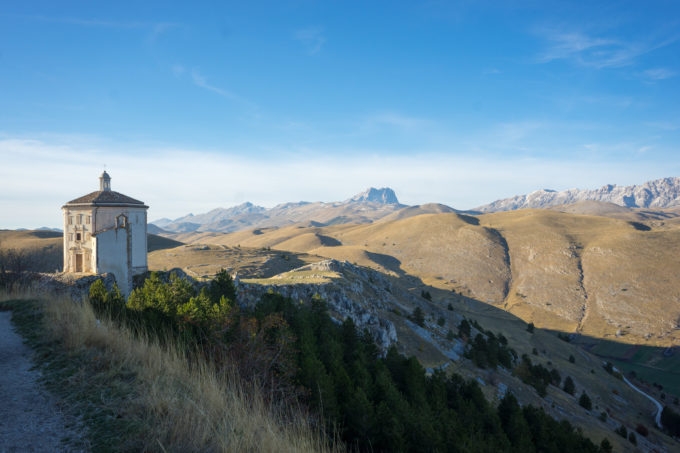
Santa Maria della Pietà church and surrounding countryside
Abruzzo is the most unexpected region we have visited to date. The dramatic landscape, the forlorn hilltop towns with their maze-like centres, the warmth of the people and the rustic comfort food make it a region we will be back to visit again soon. Despite being about a ninety minute drive from Rome, Abruzzo does not make it on most people’s lists of places to visit. It had always been on my radar and when were invited to pick saffron during the children’s holiday from school last October, I could not refuse. We were not disappointed.
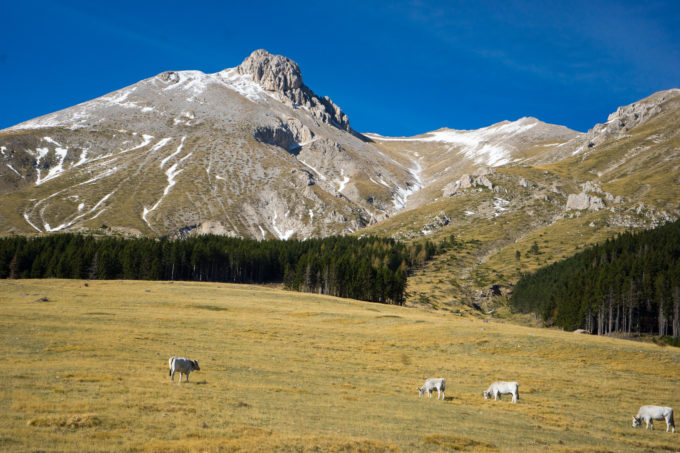
Campo Imperatore
We stayed in Rome for 2 days and then drove over to Abruzzo, stopping just over the border in Carsoli at L’Angolo d’Abruzzo for platters of local salumi, homemade pastas made from ancient grains and grilled pork, scamorza cheese, lamb, veal and beef accompanied by roasted porcini mushrooms and deep-fried battered courgette/zucchini flowers stuffed with burrata cheese and anchovies. It was a triumph of a countryside lunch and an impressive introduction to the region.
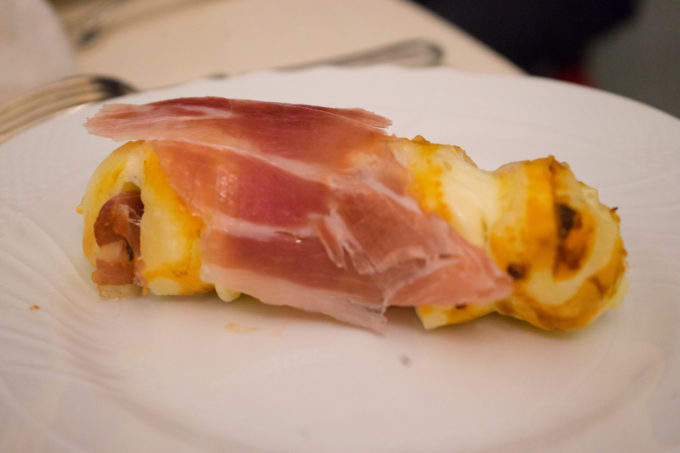
Grilled scamorza cheese with prosciutto
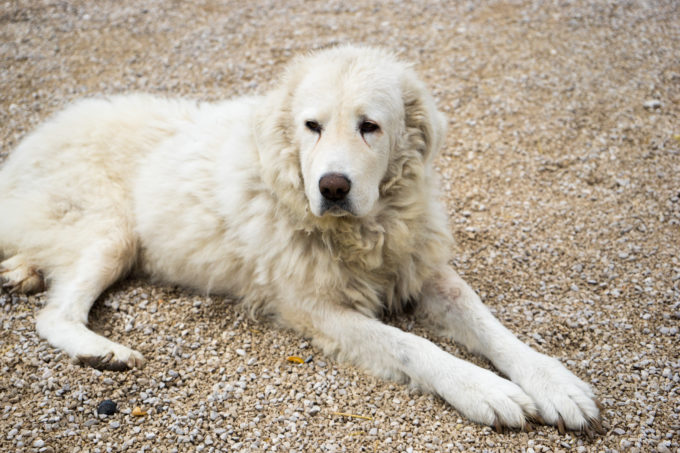
Abruzzese mastif
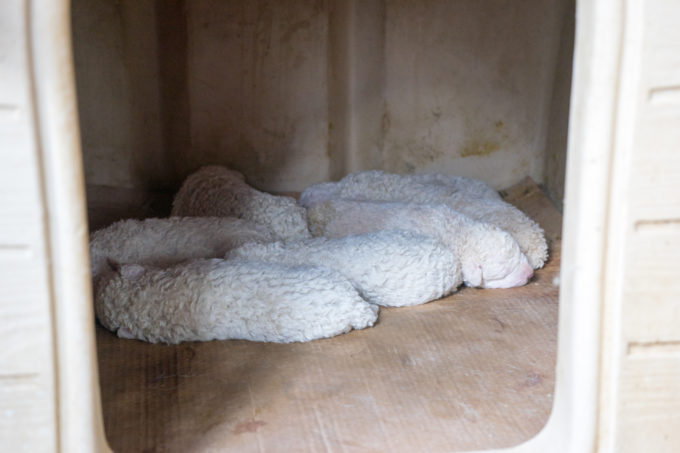
Abruzzese mastif pups
Anversa degli Abruzzi and Sulmona
We went to Anversa degli Abruzzi to stay at Porta dei Parchi, an organic agriturismo (holiday farm) that uses sustainable energy sources to make cheese and salami. We arrived in time for lambs to be born and my children were astonished by how quickly the number of adorable lambs multiplied during our stay. There were also pigs, ducks, chickens, donkeys, goats and innumerable kittens and Abruzzese mastif puppies. These dogs are typical throughout Abruzzo as they are the traditional shepherd dog, excellent at guarding livestock.
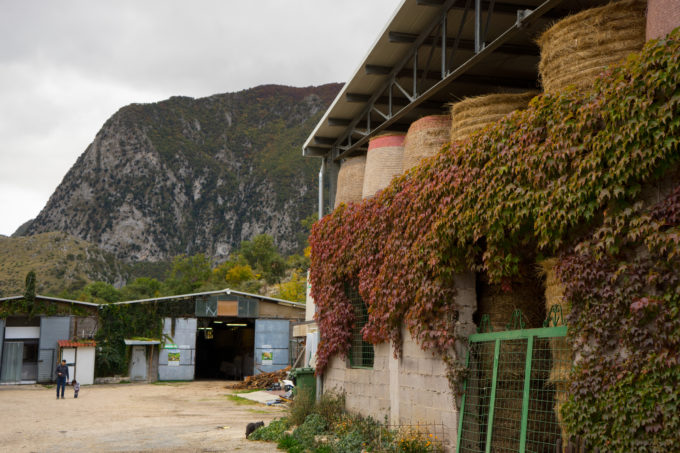
Porta dei Parchi
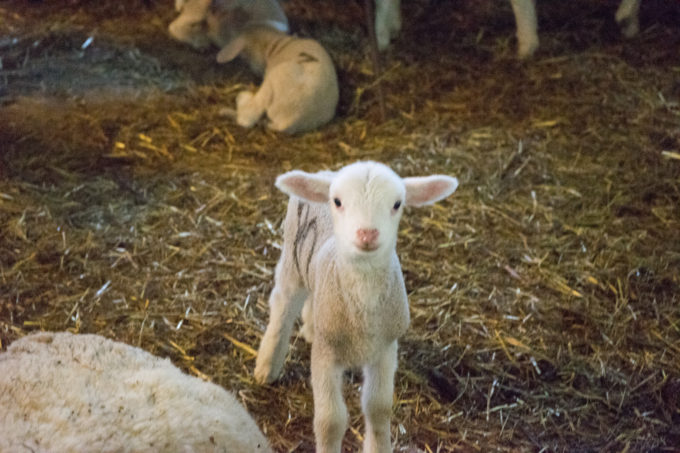
A baby lamb born during our stay
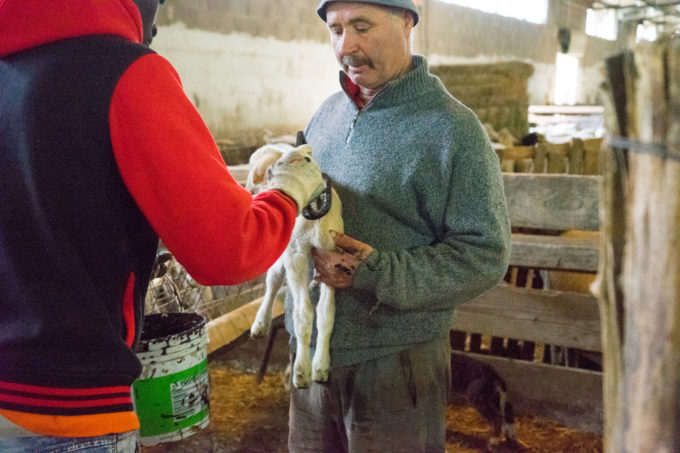
Baby lambs being numbered with their mother
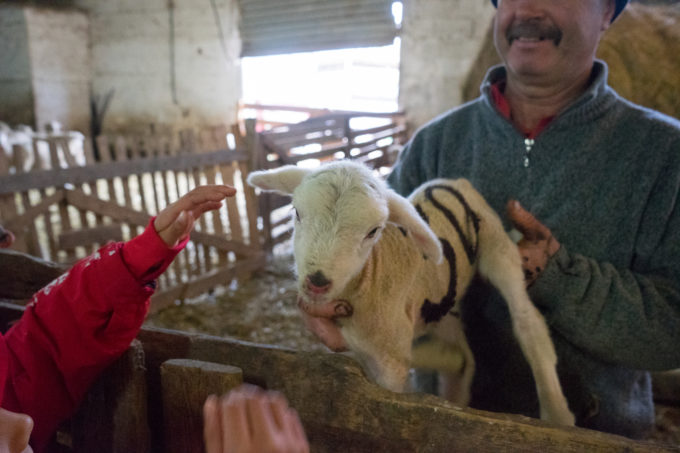
My children meeting the new lamb
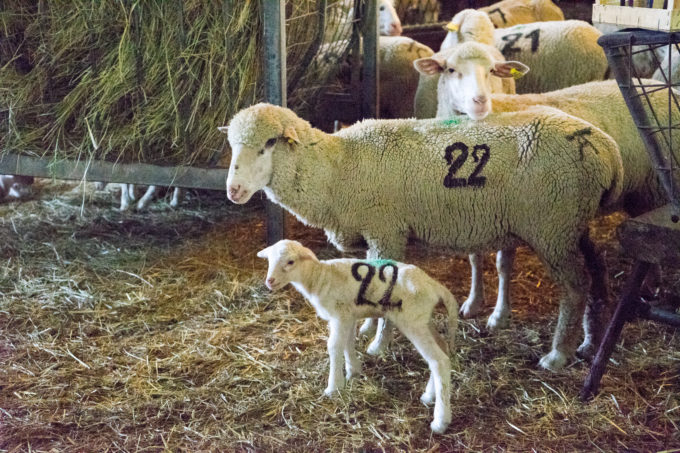
Mother and baby reunited
For dinner that night we were presented with platters of homemade cheeses (smoked ricotta – with juniper, with tomato and chilli, with black truffle, with herbs and with garlic and onion, semi-mature pecorino cheese, mature pecorino cheese) and salumi (liver sausage, lamb sausage and prosciutto).
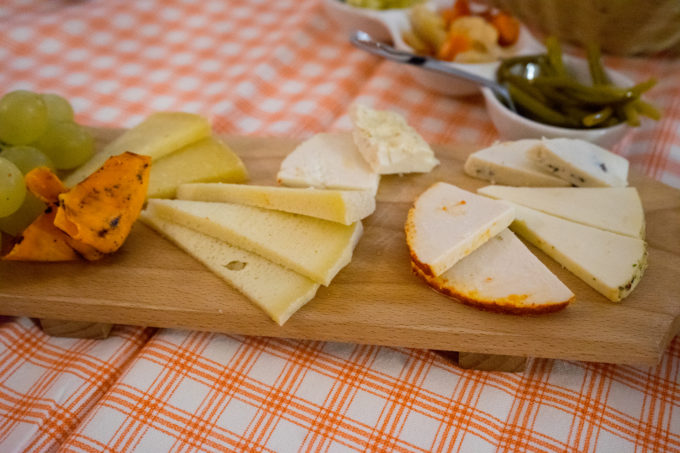
Homemade cheeses
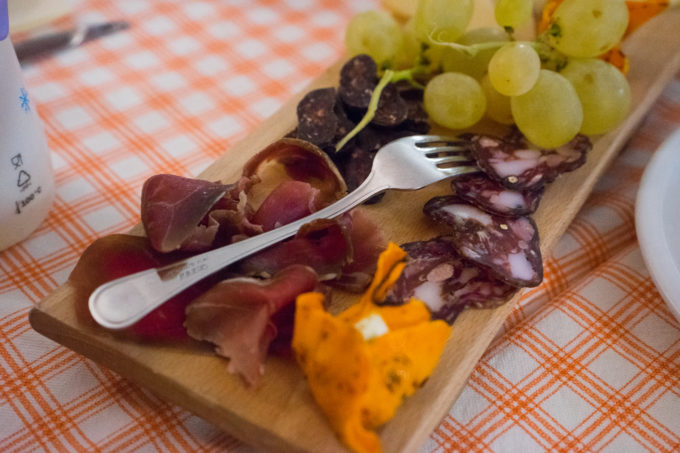
Homemade salumi
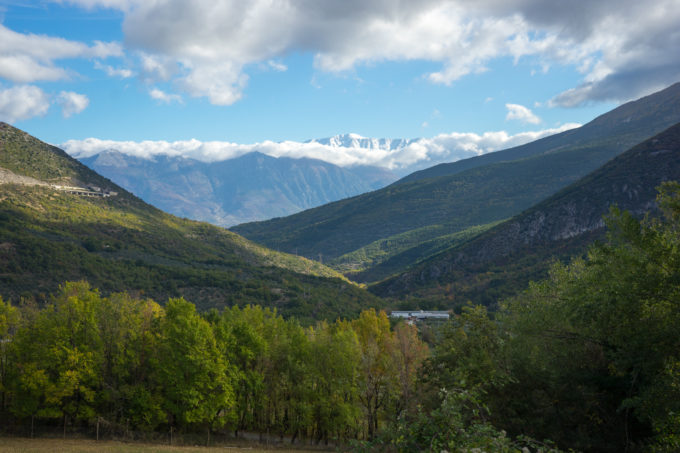
The view from Porta dei Parchi
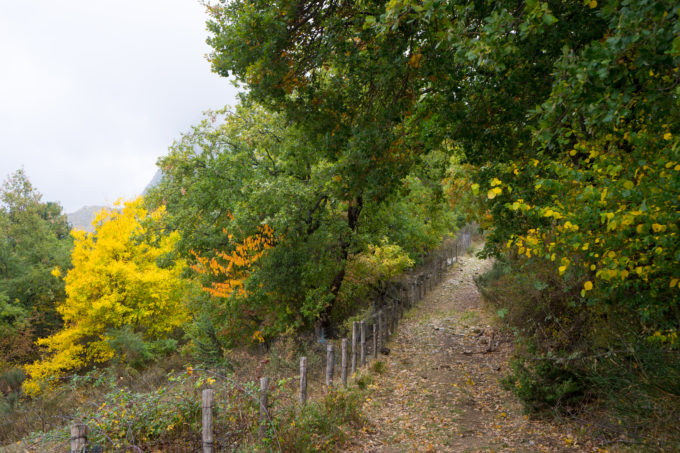
A country wander in Porta dei Parchi
Very near to Anversa d’Abruzzo is Sulmona, a Baroque town synonymous in many Italian’s minds with sugar coated almonds known as confetti given at weddings and as the birthplace of the Roman poet, Ovid. The most famous of the confetti producers is Pelino whose factory and museum we visited. Confetti were first created at the end of the 15th century by the nuns at the Santa Chiara convent. They have a permanent presence at weddings as it is said the bitter almonds and the sweet sugar are representative of the ups and downs of marriage. At Pelino, they come in an astounding array of coloured flower bouquets and even adorable figurines for the children. Many are works of art in their own right. They can be made with almonds, hazelnuts, chocolate and/or candied fruit. While in Sulmona, its worth stopping at the Palazzo de”Annunziata to see four centuries of Sulmonese art. On Tuesday mornings there is also a food market in the historic centre of town.
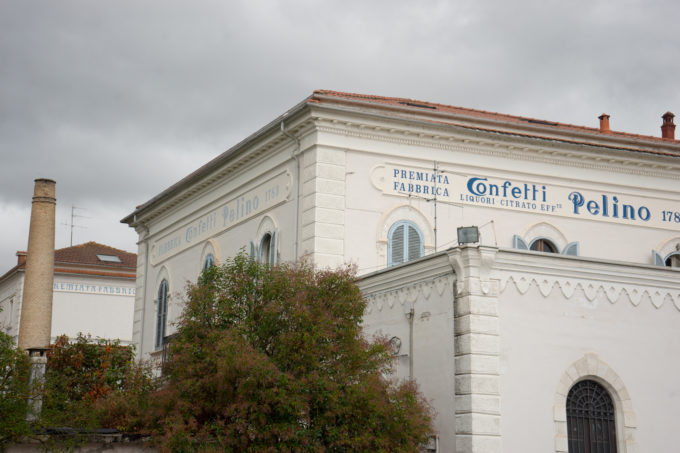
The Pelino factory and museum
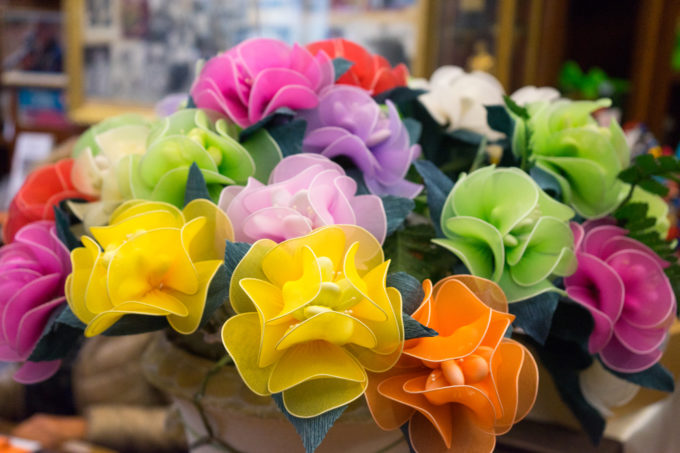
Sugar coated almonds made into flowers
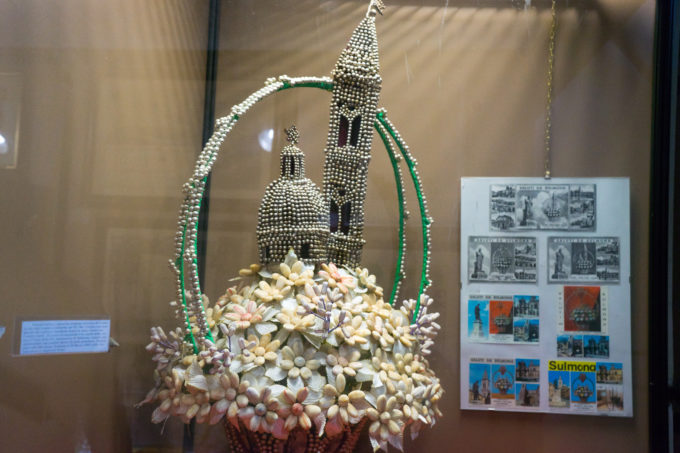
A confetti masterpiece
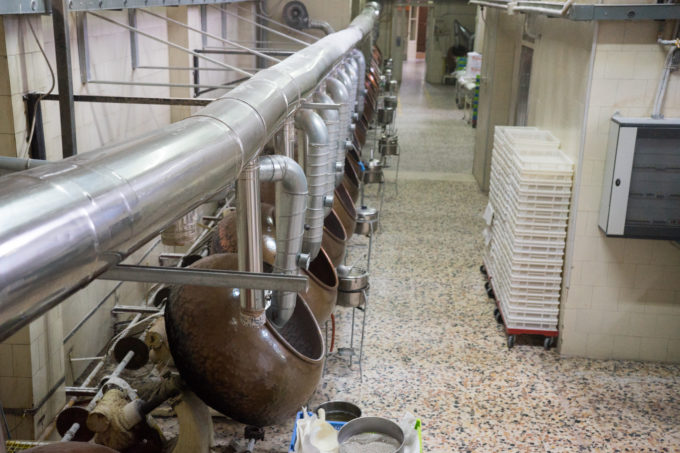
The factory where the almonds are coated in sugar
The cuisine of inland Abruzzo is focused on a sort of pastoral cuisine with their local cheeses such as scamorza, Canestrato, caciocavallo, Caciofiore and ricotta and local salumi such as salami, sausages, prosciutto and Mortadella di Campotosto (easily identified by its core of pure white lard). It is also rich in tiny, delicate lentils like those from Santo Stefano di Sessiano, farro (emmer wheat), ancient wheat grains such as Solina, honey, dried figs from Atessa, chickpeas and saffron from Navelli, red garlic from Sulmona, beans from Paganica, grapes, potatoes, sweet peppers, white onions and black truffles. In Sulmona, Pignatelli Tartufi produce an array of truffle products such as truffle sauces, truffle honey and truffle oil which can be purchased at their shop downtown. Try La Fiaccola in Anversa degli Abruzzi for truffle dishes. North of Sulmona in Pratola Peligna, stop by Masciarelli, a family-run, traditional pasta maker since 1867, to stock up on pasta made from locally grown wheat.
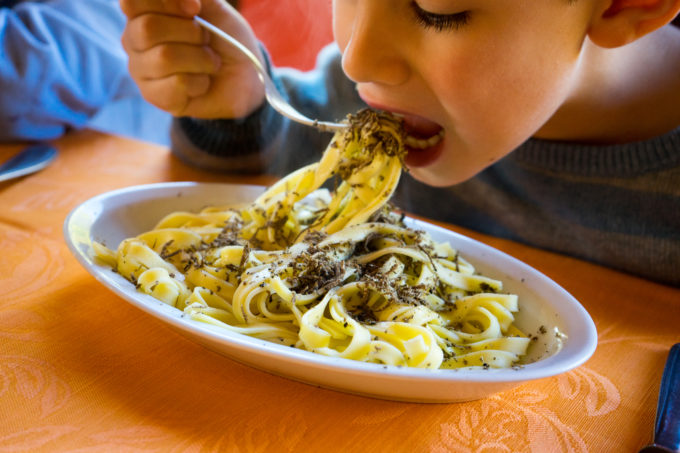
My son tucking into a plate of pasta with black truffles
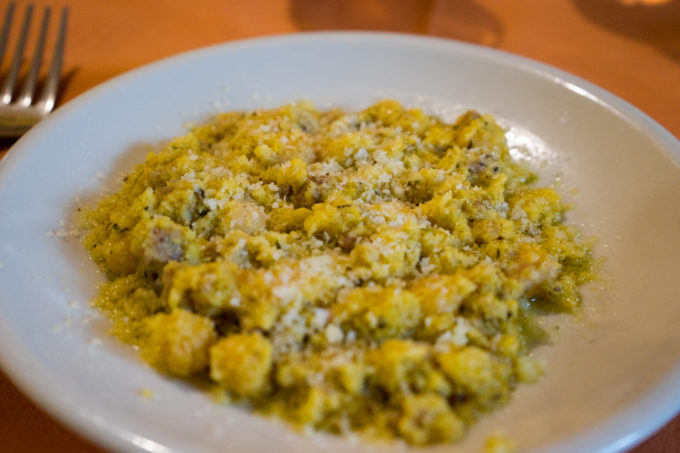
Polenta with black truffle, chickpeas, onion and sausage
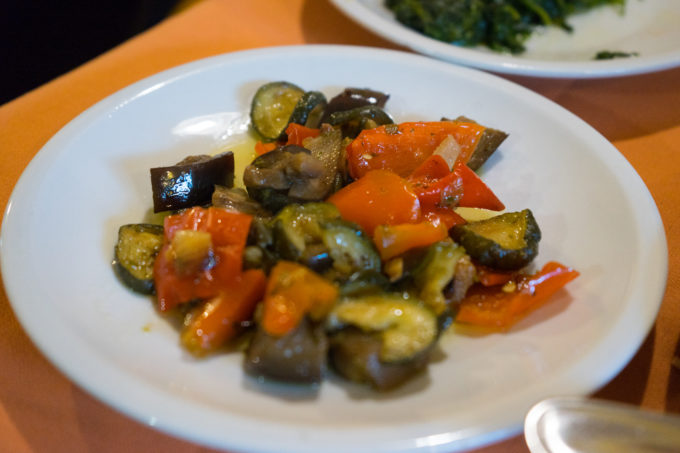
Ciabotto– baked peppers, courgette/zucchini, aubergine/eggplant and onion
Scanno
Heading south from Anversa degli Abruzzi, the stunning countryside of the Gran Sasso National Park offers views of Alpine-like lakes, historic hillside towns and mountain passages. We were hoping to make it to Scanno and then onwards to three scenic mountain towns: Rivisondoli, Pescocostanzo and Roccarso but decided to spend more time around Scanno.
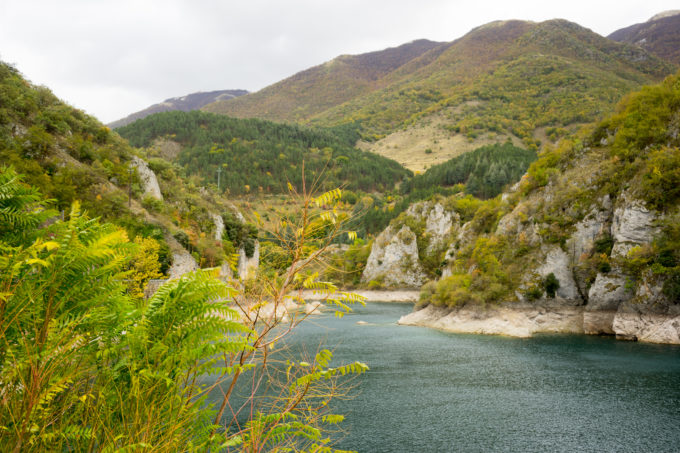
Scanno Lake, legend has it that it was formed by a feud between a witch and a sorcerer. The lake was formed when the witch fell.
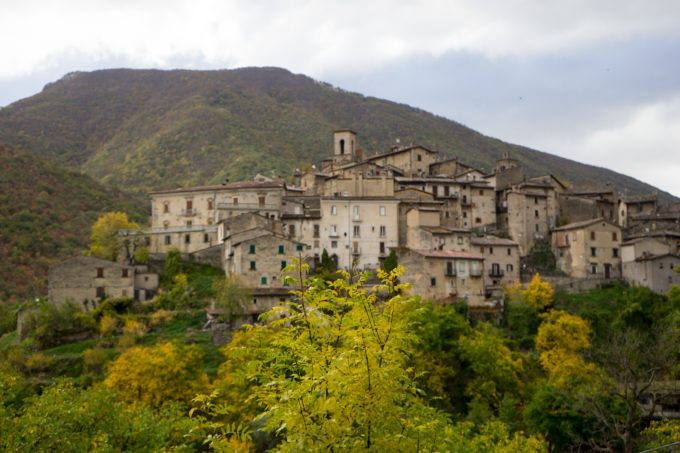
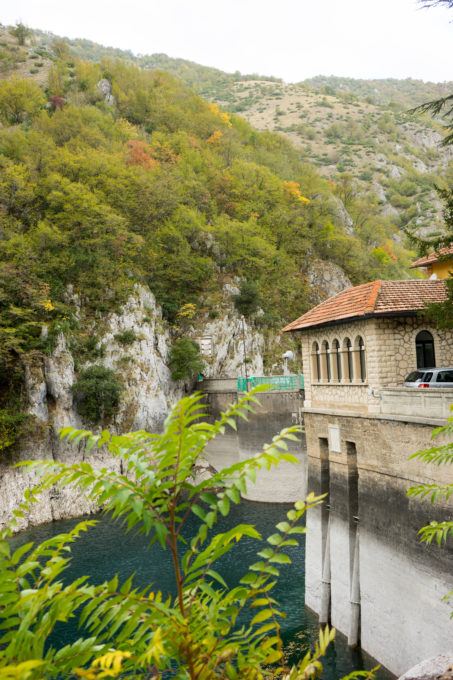
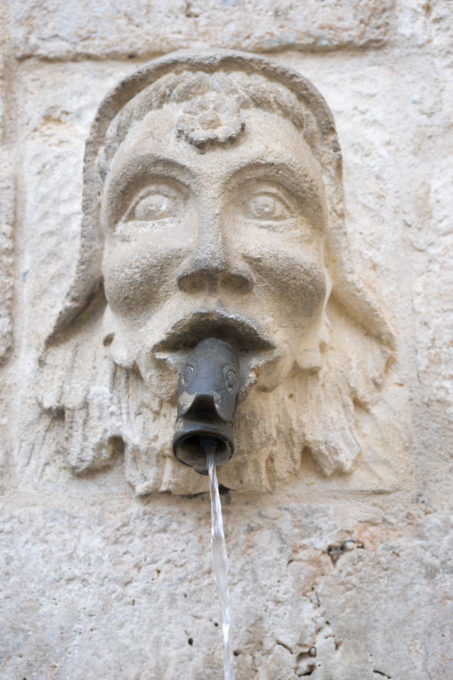

In Scanno itself, there is a famous pastry shop, Pan dell’Orso Pasticceria, renowned for its invention of the Pan dell’Orso, an almond and honey cake coated with chocolate. They are also known for their mostaccioli biscuits made using a 18th century recipe. The bakery’s philosophy is to recreate local, ancient flavours but using more modern techniques.
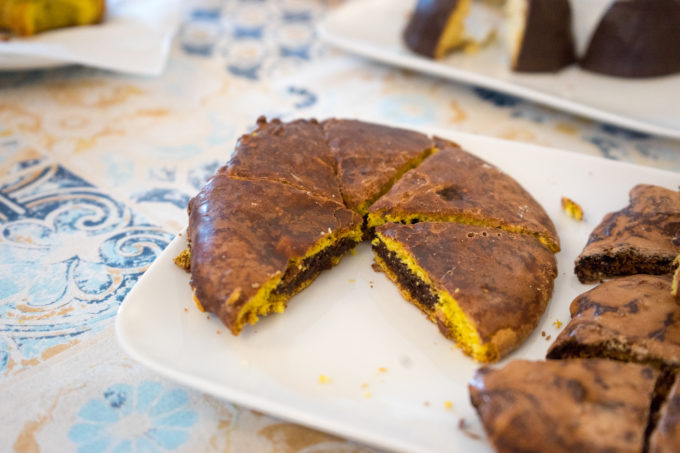
Mostaccioli with a soft centre made with a traditional recipe from Pan dell’Orso Pasticceria
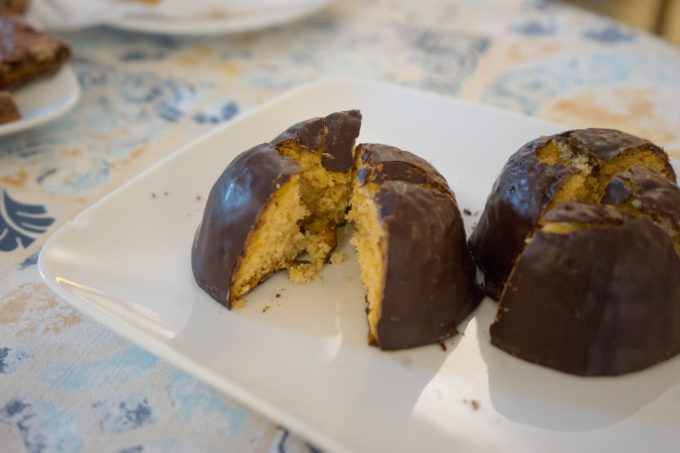
Pan dell’Orso (an almond and honey cake coated in chocolate) from Pan dell’Orso Pasticceria
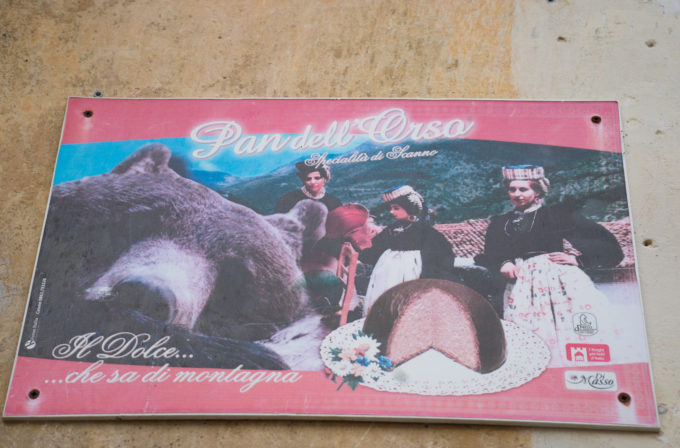
Advertisement for the Pan dell’Orso showing the traditional dress for ladies from Scanno
There is also an artisanal biscuit bakery, Biscotteria Artigianale, which specialise in mostaccioli (chocolate, almond and grape must biscuits) as well and an enormous chocolate and almond biscuit called the Biscotto di Prato. Many people come to Scanno for outdoor sports such as canoeing, fishing, windsurfing, mountain biking and skiing. Scanno has some lovely churches and architecture and is also famous for its elaborate gold jewellery and lace making.
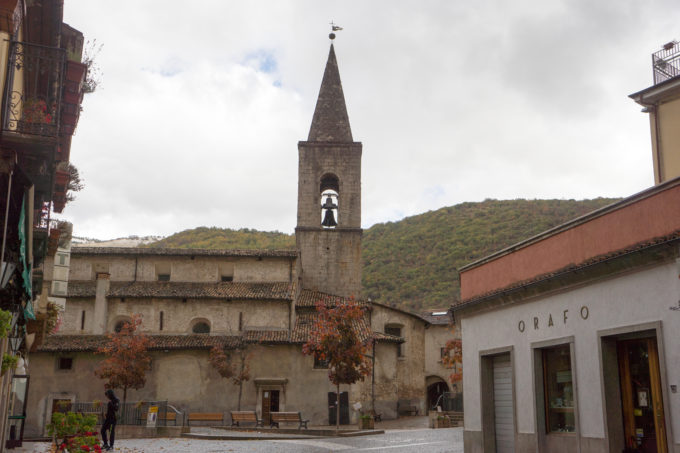
Scanno
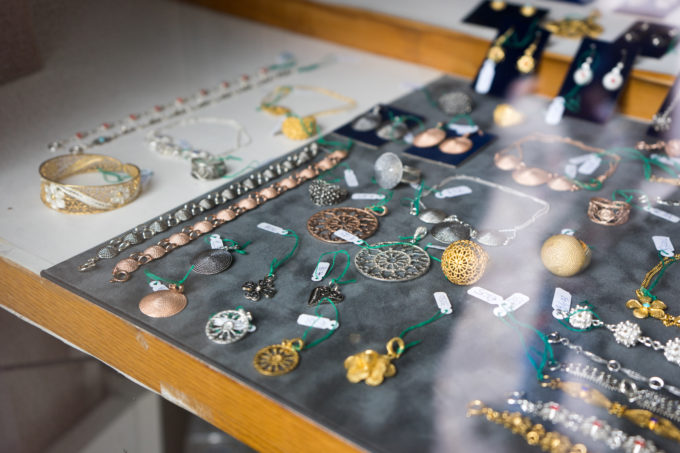
Scanno‘s gold filigree jewellery
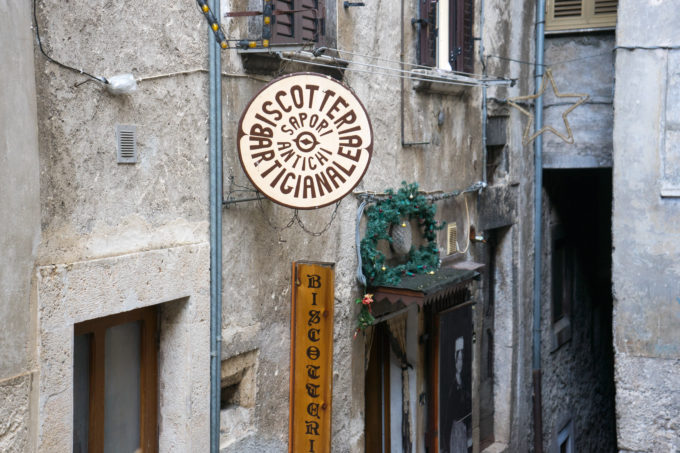
Biscotteria Artigianale
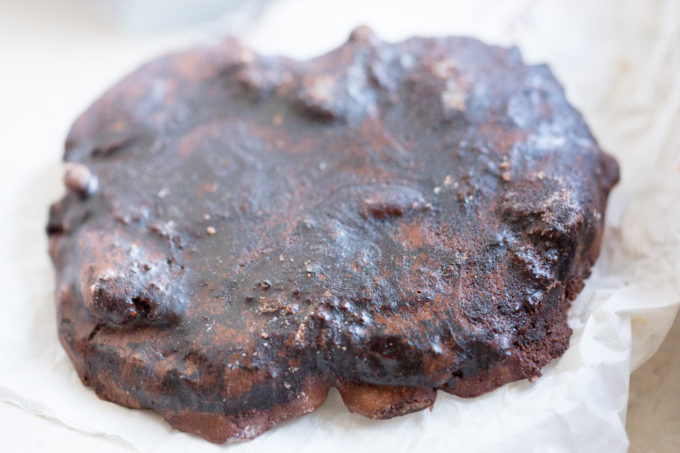
Mostaccioli (chocolate, almond and grape must biscuits) from Biscotteria Artigianale
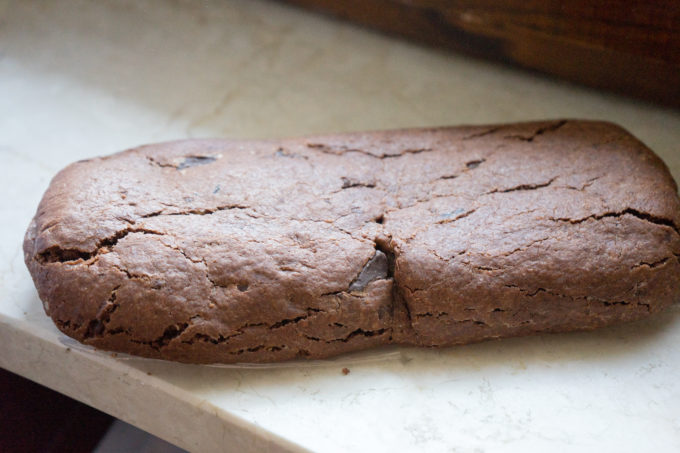
Biscotto di prato (an enormous chocolate and almond biscuit) from Biscotteria Artigianale
Navelli and its saffron
We headed north to Navelli in the wee hours of the morning in time to catch the new crocus buds emerging from the earth. The morning was still quite chilly and excitedly, with frozen fingers, we worked to gently pick the buds from the bottom and collect them in baskets. Gina Sarra greeted us in the field encouraging the children to pick the buds and showing them how the stamina inside, when dried, would become saffron (sometimes called red gold due to the high prices it commands).
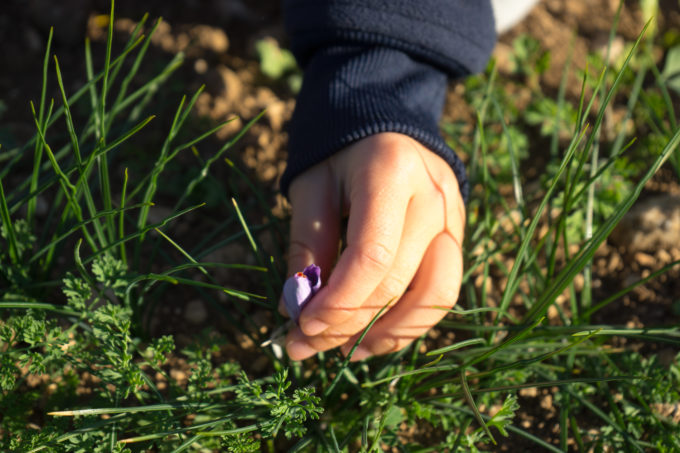
My son collecting crocus buds
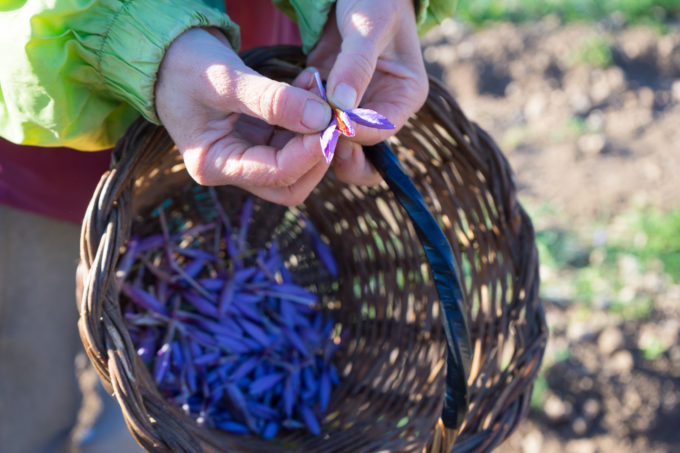
A basket of crocus buds
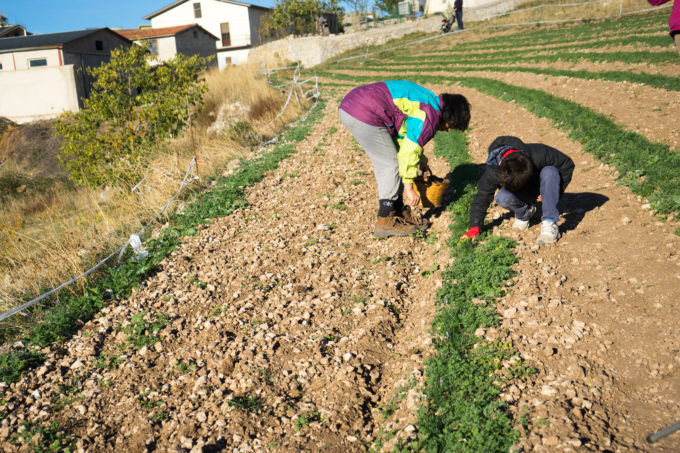
Gina Sarra and my son collecting buds
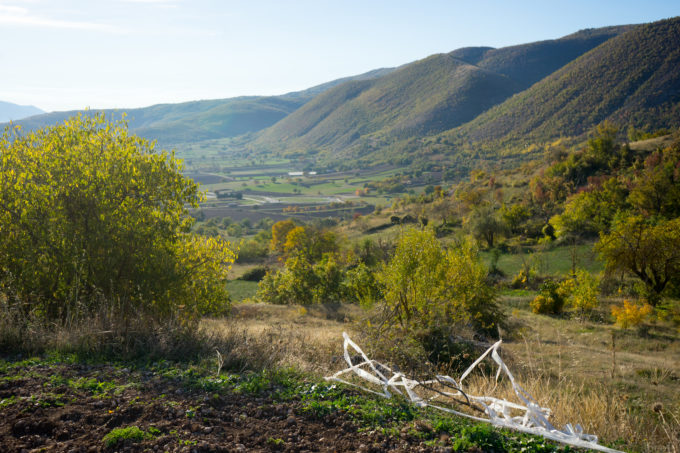
The view from the field down into the valley below
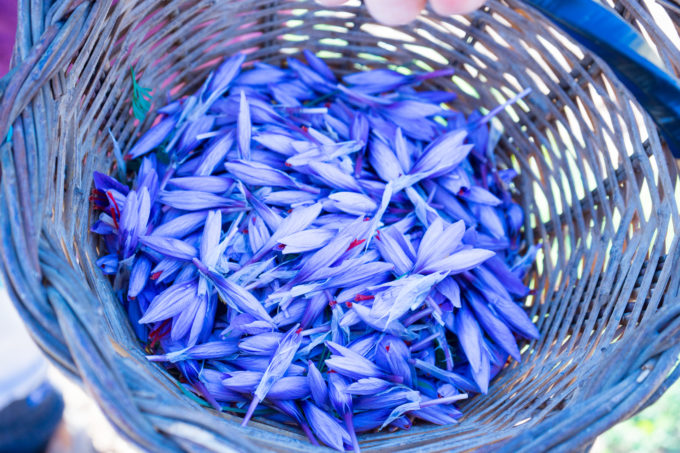
Crocus sativus buds
When our hard work was finished we decamped to Gina’s house to warm up with some hot coffee. We were mesmerised by her aunt who was adeptly twisting the base of the buds to separate the stamens from the petals. In the time that the 5 of us managed to do a small pile of flowers, her aunt easy amassed a large pile of stamens. We now appreciate why saffron is one of the most expensive foods available. It takes around 150,000 crocus flowers to make 1 kilo of dried saffron! Fortunately a little goes a long way.
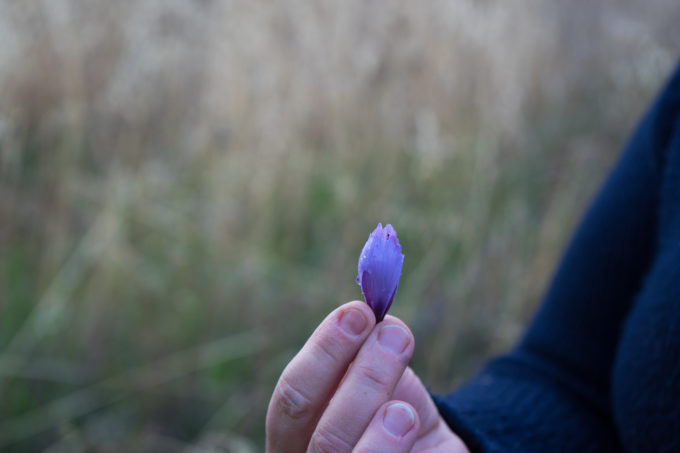
Demonstrating how to twist open a crocus sativus bud: step 1- grab the bud by its base
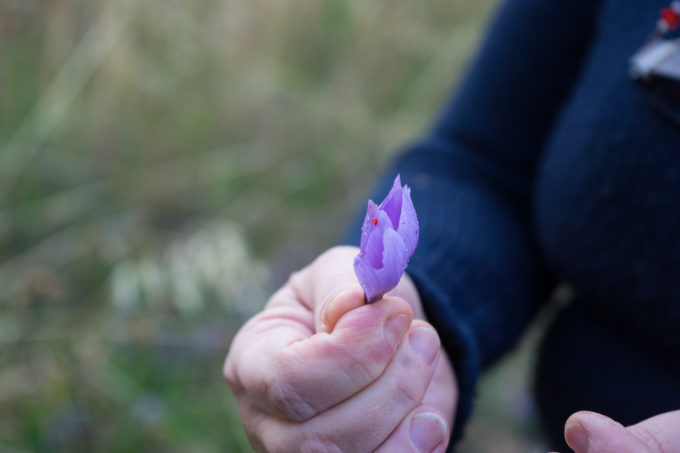
Step 2: twist your fingers
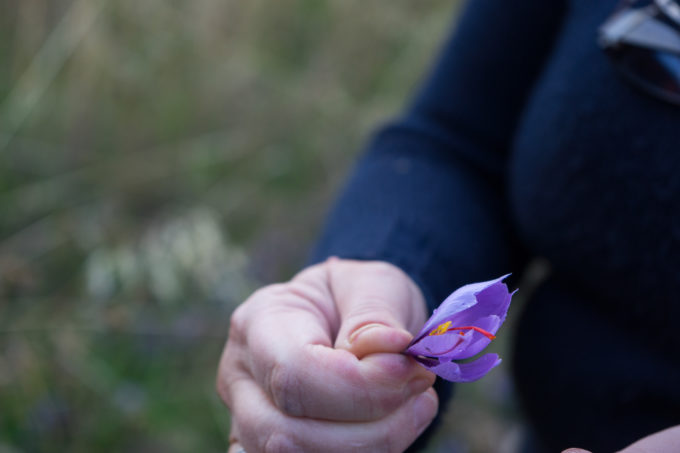
Step 3: expose the stigma and separate
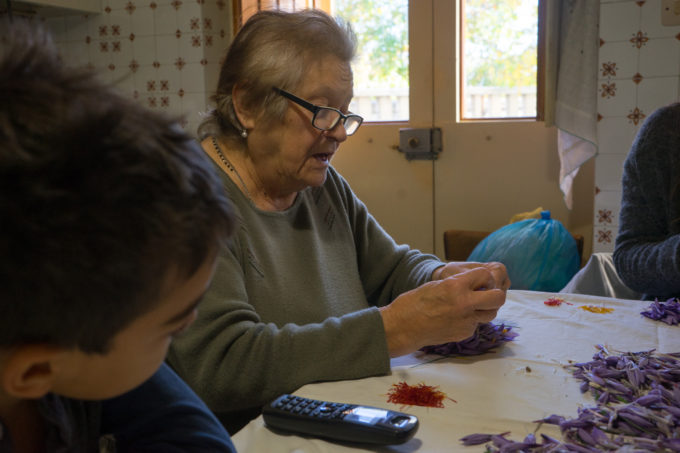
Gina’s aunt chatting as she separates the out the saffron’s red stigma from its yellow stamen and purple petals
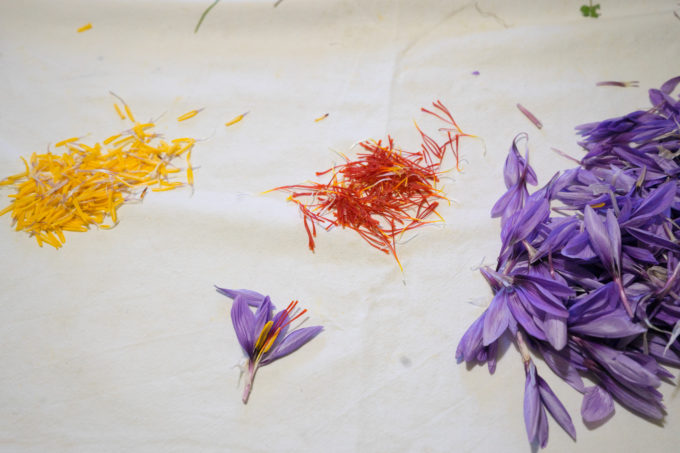
Red saffron stigma, the yellow stamen and the purple petals
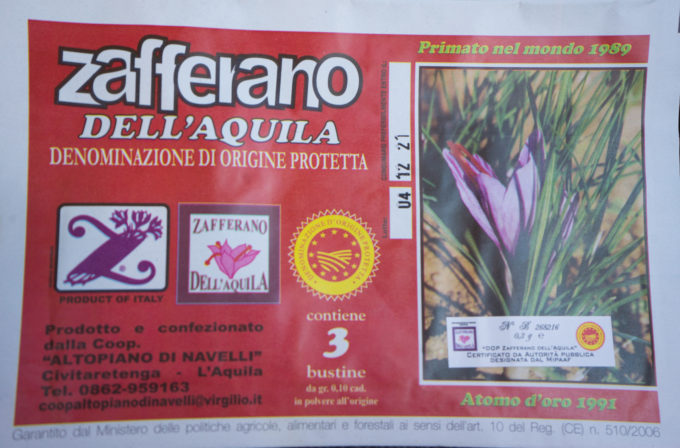
The saffron once its is dried and packaged.
Calascio and Castel del Monte
We next stayed at the nearly abandoned town of Calascio, home to extraordinary Rocca di Calascio, the highest fortress in the Apennines mountains. The fortress was constructed between the 10th and 13th centuries and was badly damaged in a earthquake in the 15th century. Hiking up and viewing the surrounding countryside was a highlight of our trip.
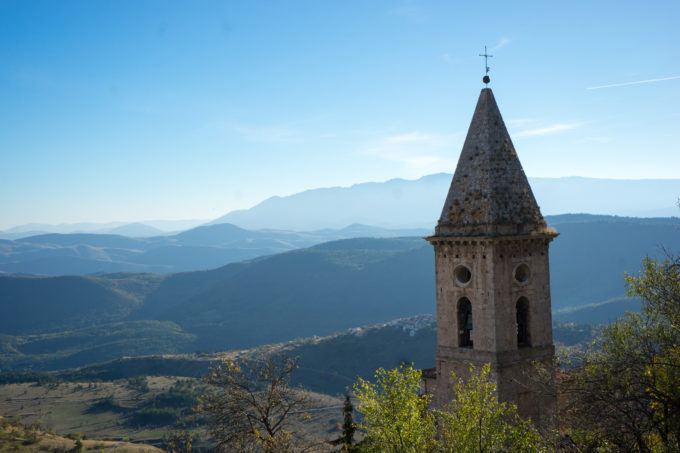
View from Calascio town
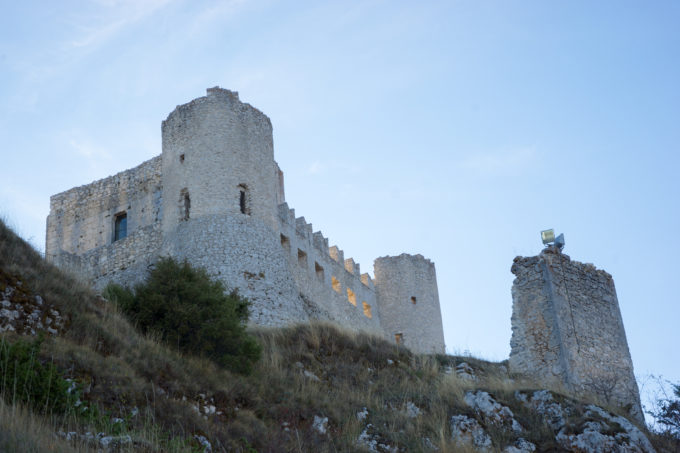
The Rocca di Calascio fortress
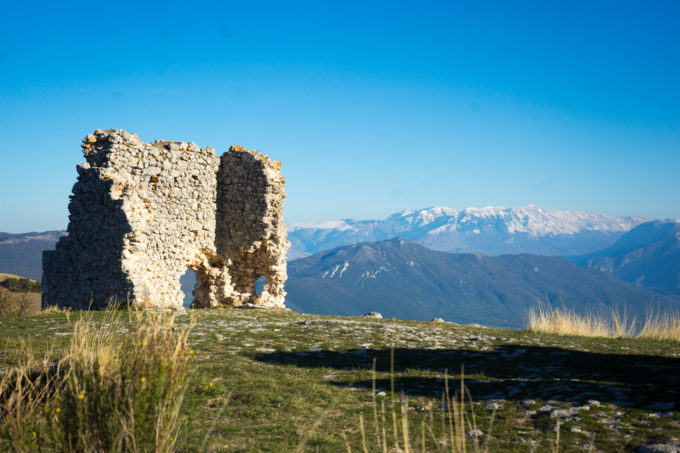
The Rocca di Calascio fortress
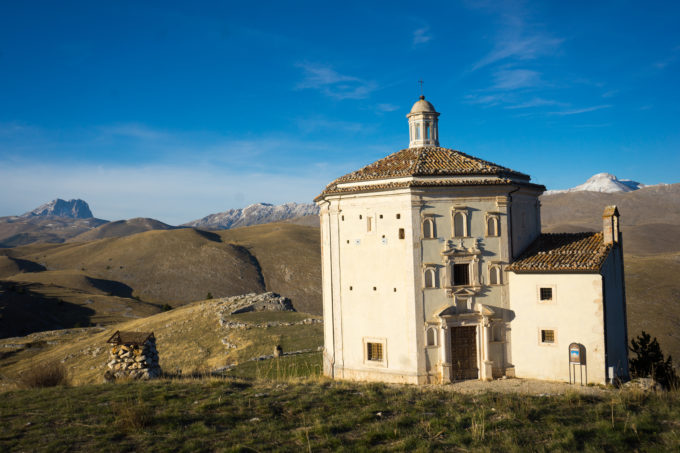
Santa Maria della Pietà, an octagonal church built in the seventeenth century located next to the Rocca di Calascio
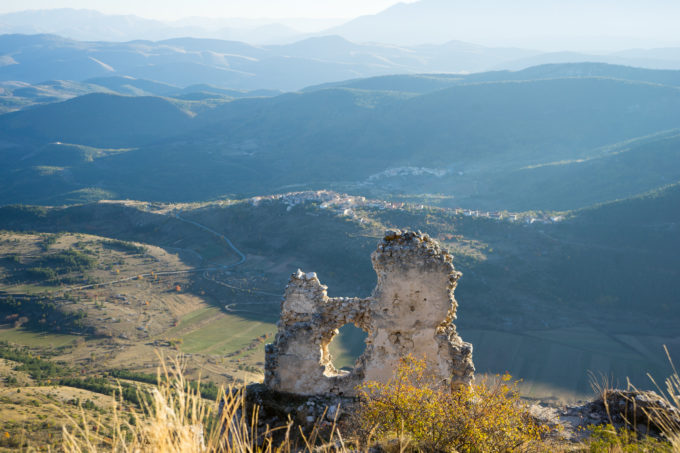
Rocca di Calascio
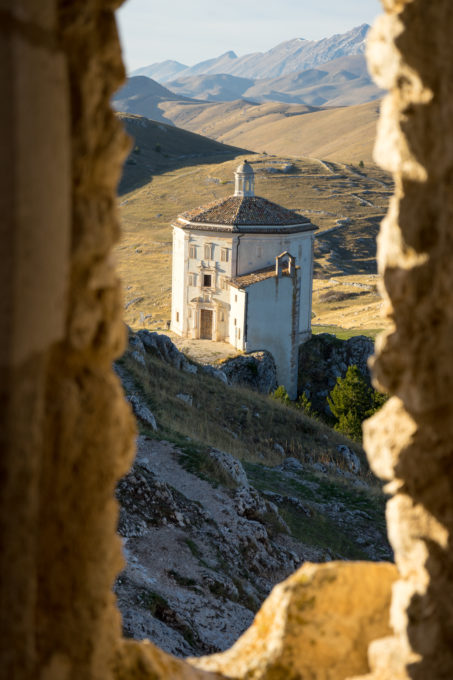
Santa Maria della Pietà church seen from the Rocca di Calascio
Nearby Calascio we stopped in a roadside restaurant, La Cabina in San Pio delle Camere, for a satisfying lunch of pasta with sausages, porcini mushroom and saffron, pasta with black truffles, pasta with saffron, guanciale and ricotta, black truffle omelettes and grilled sausages.
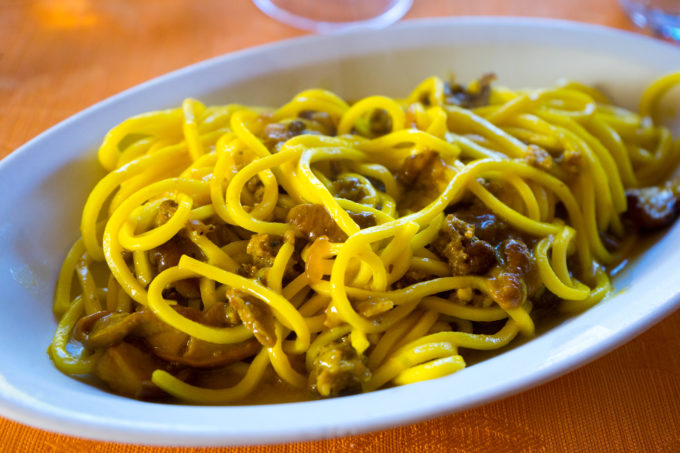
Chitarrina con zafferano, salsiccia e porcini (square-cut spaghetti with saffron, sausage and porcini mushrooms)
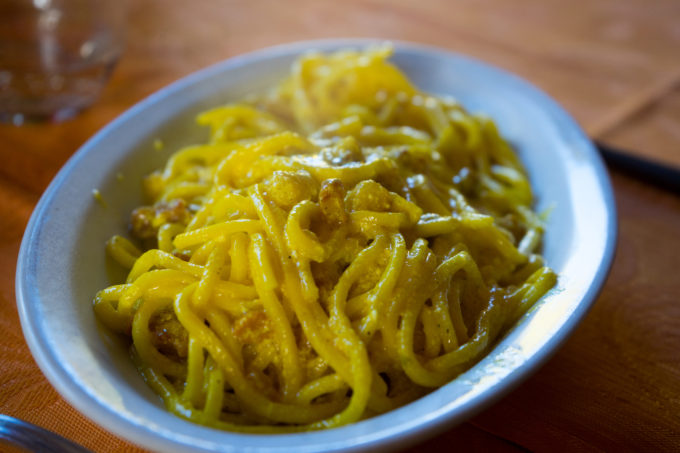
Chitarrina con zafferano, guanciale e ricotta (square cut spaghetti with saffron, guanciale and ricotta)
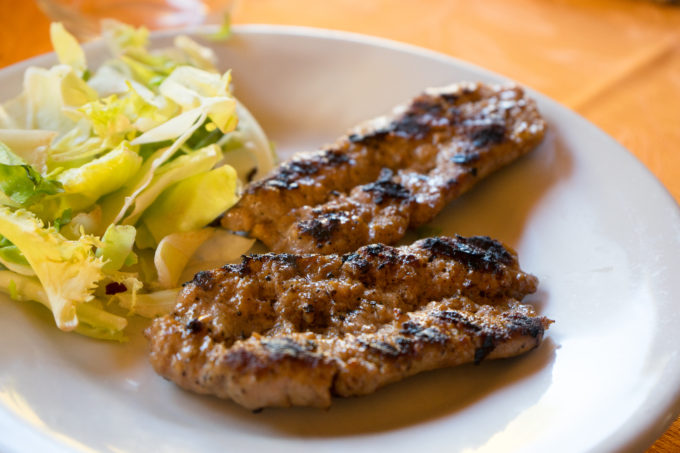
Grilled sausages
One of my favourite things to do is visit cheesemakers. In neighbouring Castel del Monte, a beautiful medieval village, just happens to live Giulio Petronio. Mr. Petronio is one of the only producers of Canestrato di Castel del Monte, a pecorino cheese which was on the brink of extinction. It is made with milk only from the Sopravvissane or Gentili di Puglia sheep, natural rennet and salt. The cheese was traditionally made with milk from the sheep which were part of the transhumance (transumanza), an ancient Italian biannual tradition where large flocks of sheep were migrated from the Apennines in Abruzzo during the summer (including nearby Campo Imperatore) to the more temperate coastal plains in Puglia in the winter. There are up to 300 different forage plants in the Gran Sasso which create ideal conditions for sheep farming. The Canestrato di Castel del Monte is pressed into shape with characteristic basket markings on the rind. It is aged for at least 2 months and is rubbed with olive oil to prevent it from drying out.
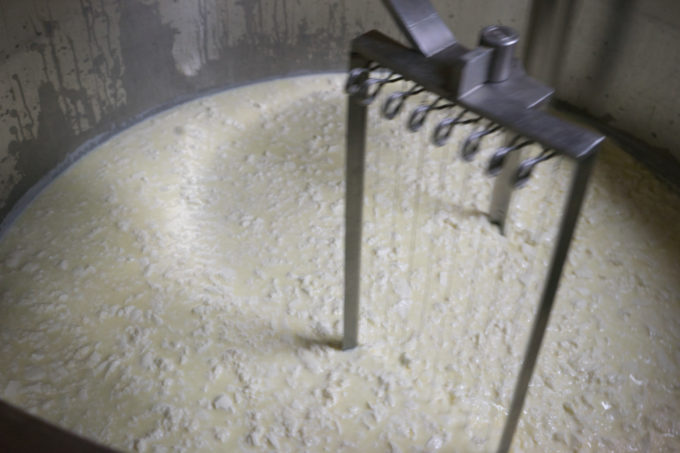
The curds beginning to form in the milk
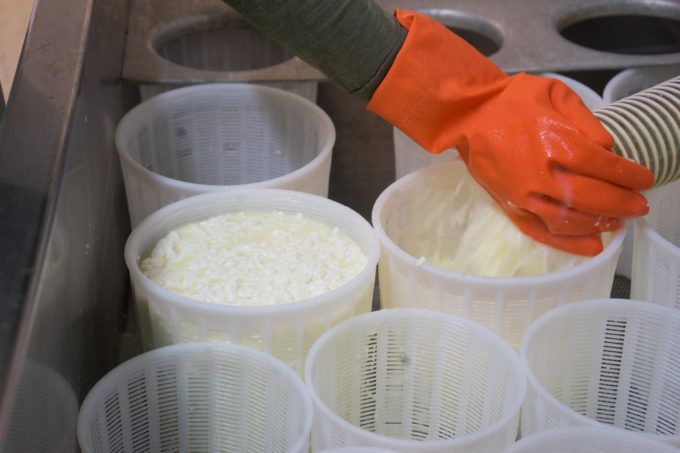
The curds being added to the perforated baskets to make ricotta
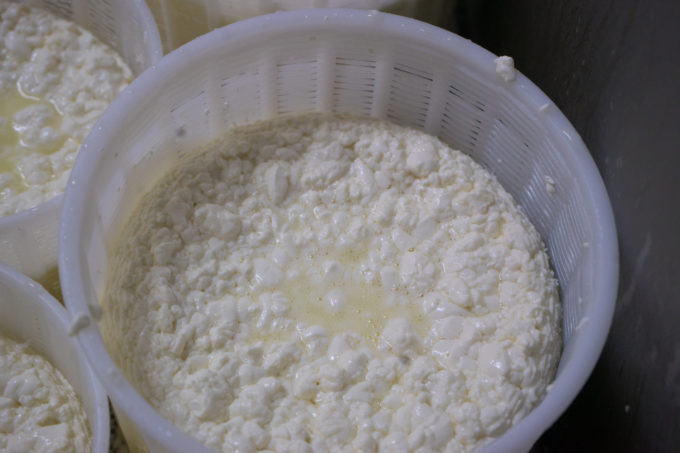
Ricotta
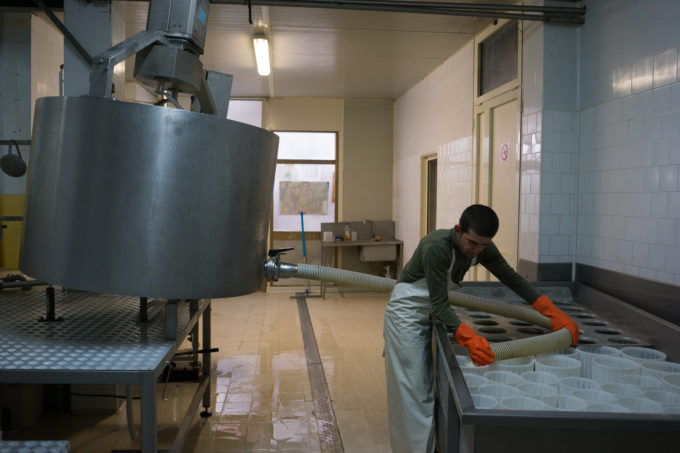
Making cheese
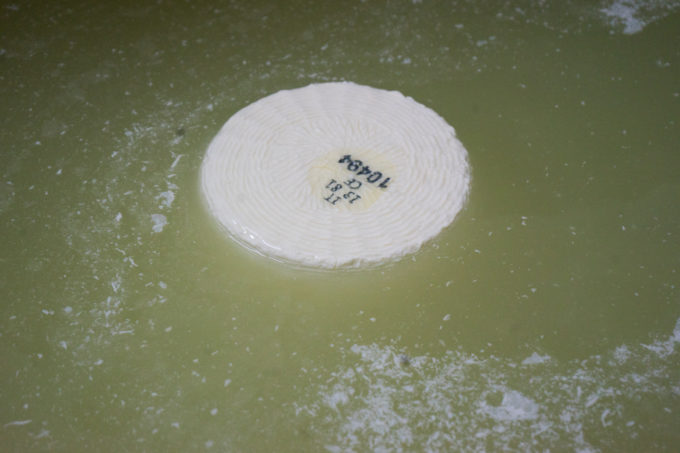
Soaking the cheese in brine
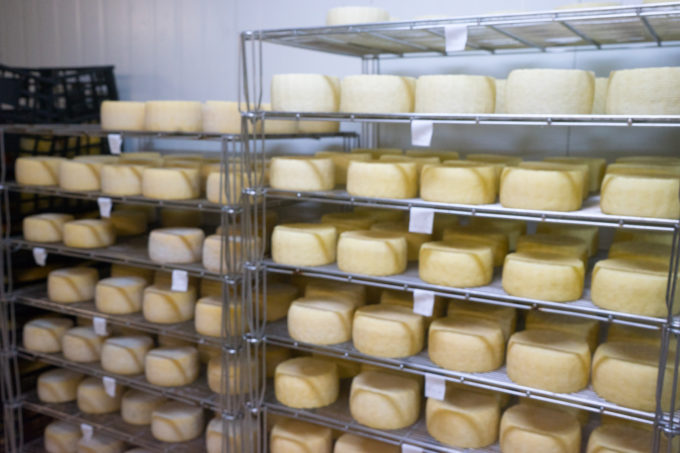
Aging the cheeses
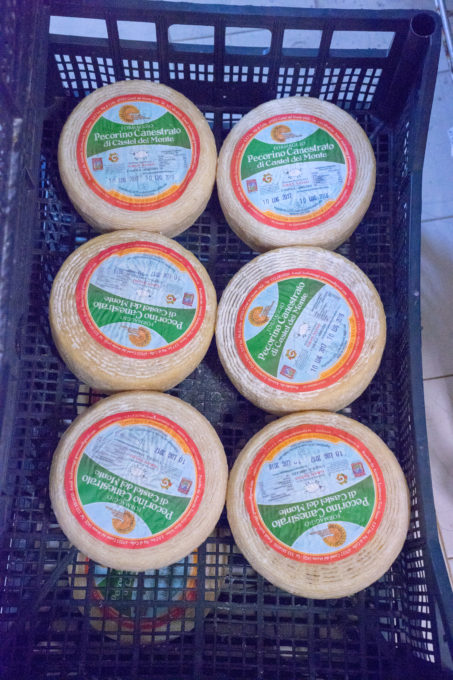
Finally the cheese is ready to be labelled Canestrato di Castel del Monte
Santo Stefano di Sessiano
Santo Stefano di Sessiano is one of the most beautiful medieval villages in the Gran Sasso National Park. Many of the buildings date between the 11th and 15th centuries but the picturesque village is largely abandoned. It reminded us of the small towns along the south of France. Santo Stefano di Sessiano is known for its tiny, delicate lentils and a luxury hotel, Sextantio (the town’s name in Roman times) which is diffused throughout the town. The pinnacle of the town was the Medici tower which fell during the earthquake in nearby L’Aquila. It was being reconstructed when we visited.
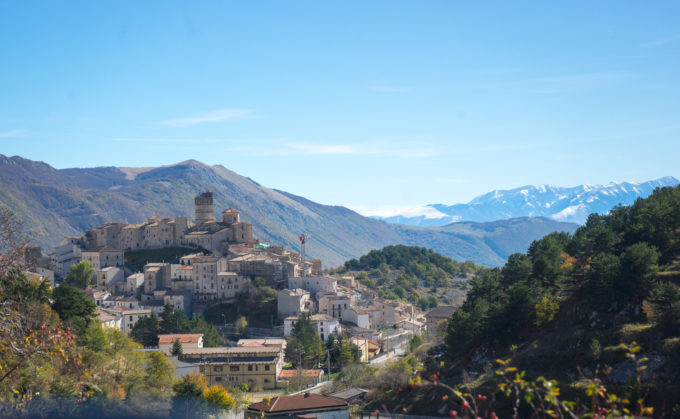
Santo Stefano di Sessiano
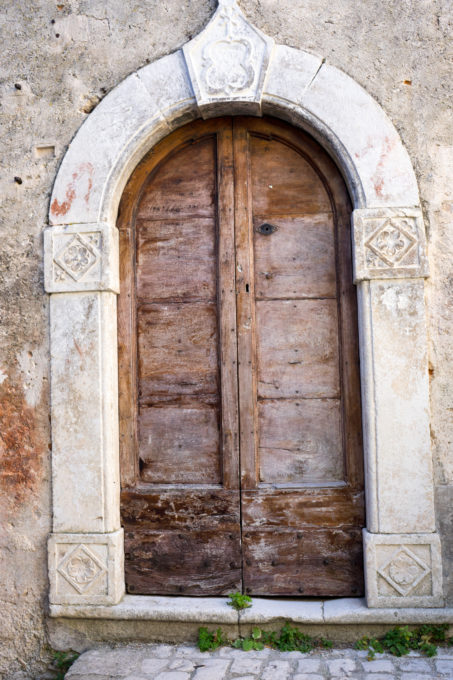
Santo Stefano di Sessiano
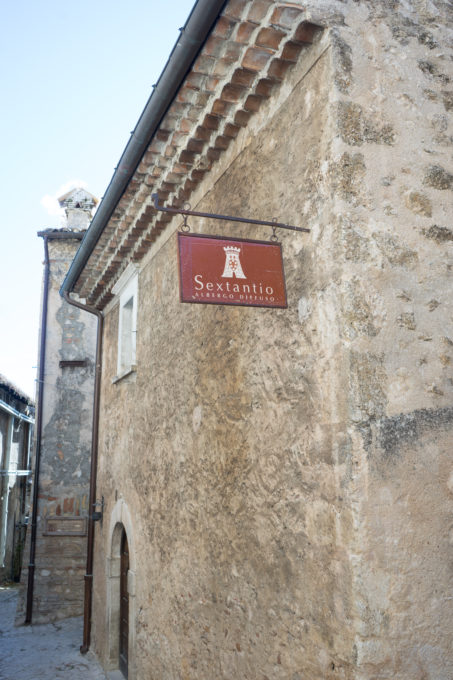
Sextantio – The diffused hotel – making use of residences throughout the village for hotel rooms
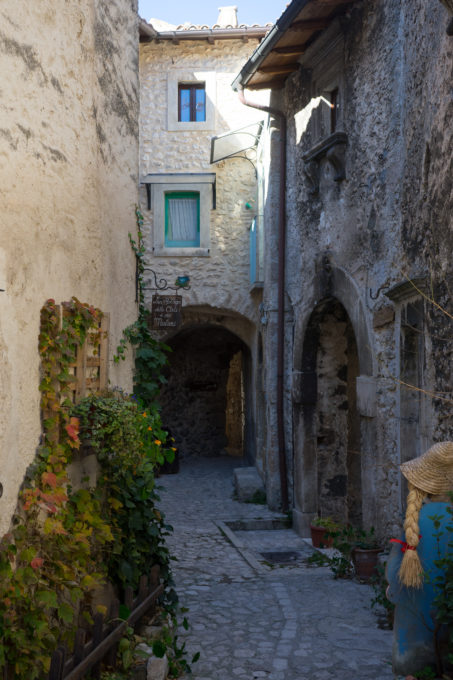
Santo Stefano di Sessiano
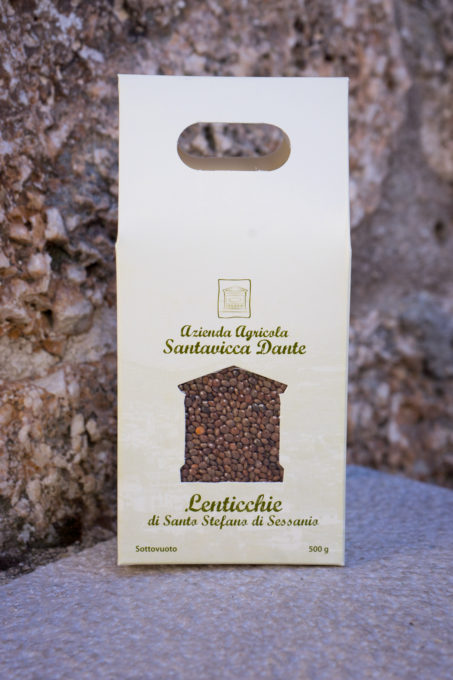
Tiny, delicate lentils from Santo Stefano di Sessiano
Campo Imperatore
A visit to Campo Imperatore, where Mussolini was imprisoned during World War II, was the absolute highlight of the trip. This 19 kilometre long wide plateau is 1,800 meters above sea level. In ancient times, shepherds brought their sheep from Puglia, Campania and Tuscany to graze here during the summer months. The transhumance has had a huge cultural impact on the areas affected. For nearly two thousand years, livestock have been brought to pasture here and thousands are still brought here to graze every May. Mr. Petronio explained to me when I visited his cheesemaking factory that 100 years ago, 500,000 sheep used to graze on the Camp Imperatore. He said when he was a child there were 30,000 sheep in Castel Del Monte alone and 5-6,000 in Calascio. Today there are a total of 13,000 sheep from all over. The transhumance used grassy paths (tratturi) to bring the sheep to pasture and one of the most important started at San Pio delle Camere and finished in Foggia, Puglia (a 15 day walk) where taxes were collected for pasturing.
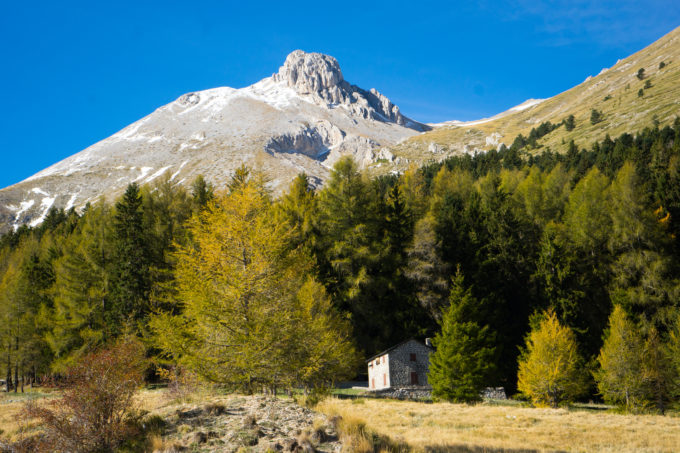
Campo Imperatore
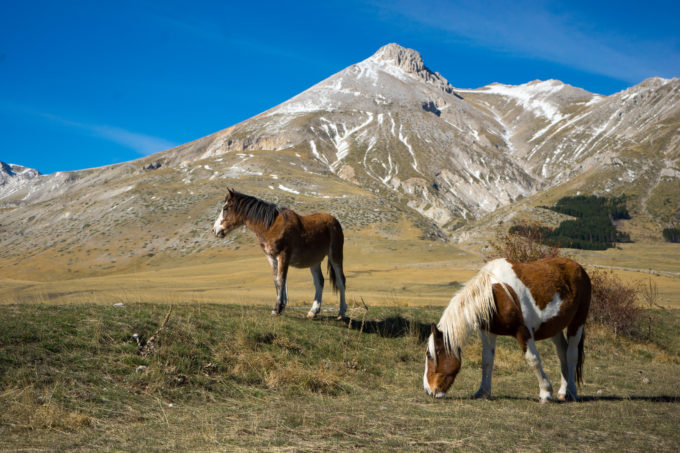
Horses grazing in Campo Imperatore
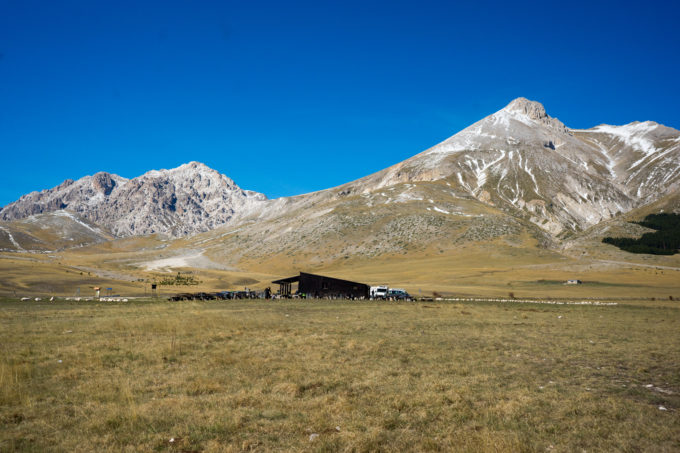
Campo Imperatore
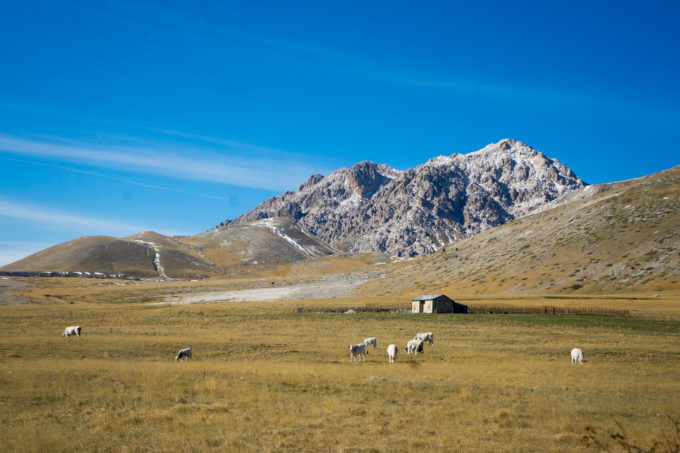
Campo Imperatore
We visited to see the spectacular scenery dotted with roaming horses, cattle and sheep. There are two restaurants on the plateau where we could buy raw meat and cheese for grilling. The restaurant set up the grill and provided bread, wine and water for purchase. A favourite amongst the Abruzzese are arrosticini (tiny cubes of lamb meat skewered and grilled). The children ran in all directions, trying to get closer to the livestock while we grilled. Everyone slept well that night.
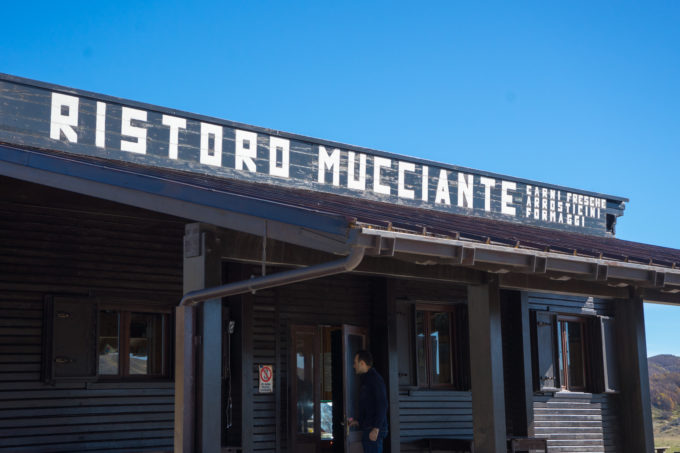
Mucciante– the place to stop and buy food to grill
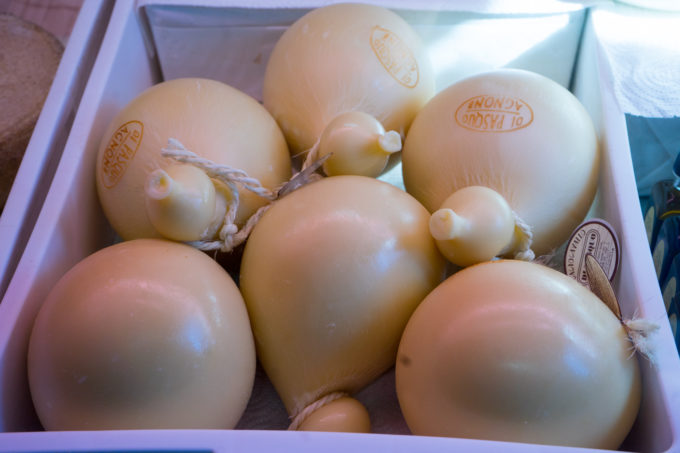
Caciocavallo cheese
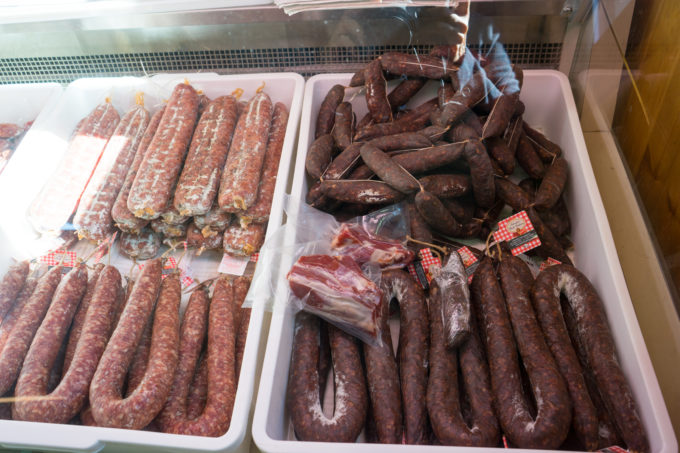
Sausages for sale to grill outside
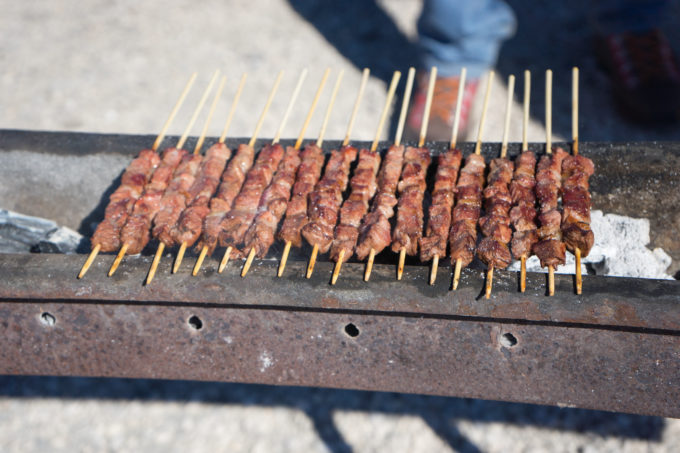
Arrosticini (small cubes of lamb, skewered and grilled)
L’Aquila
Legend has it L’Aquila was founded in the 13th century when 99 castles joined together to form a city. In the city, each castle had its own church, fountain or piazza. L’Aquila was a jewel of a town with a long history and truly amazing architecture. Sadly the town was devastated by an earthquake in 2009. The town remains under reconstruction today although the impressive facades of many of the Baroque and Renaissance buildings remain. If you go to the castle, do stop into the wine shop, La Fenice. They have an impressive collection and knowledge of local and national wine, including wines from Loreto Aprutino (an area in Abruzzo producing top quality wine).
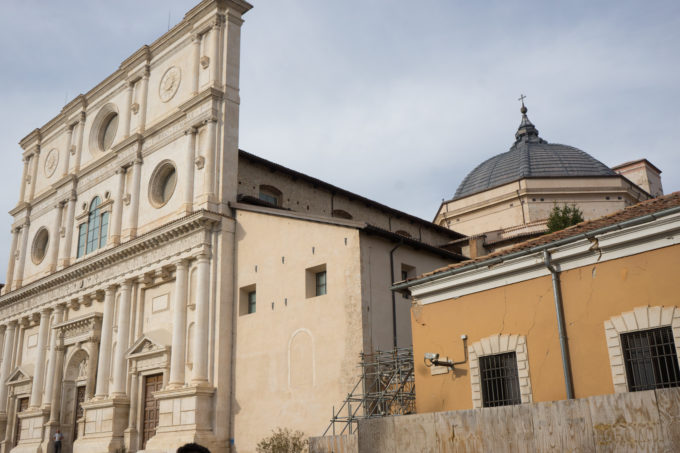
The 16th century Chiesa di San Bernardino (closed when we visited)
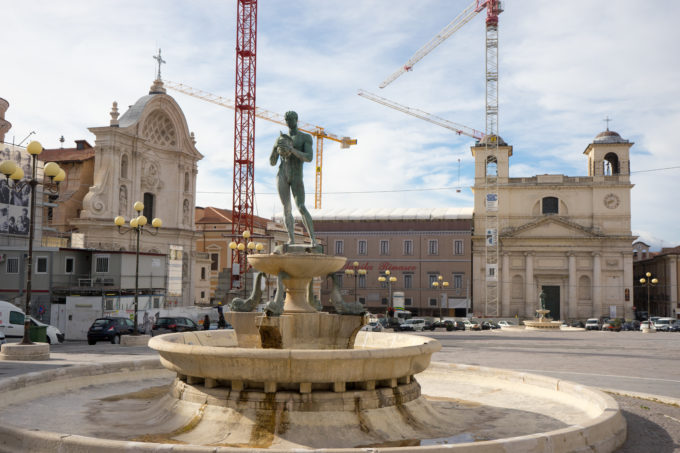
Piazza del Duomo, L’Aquila
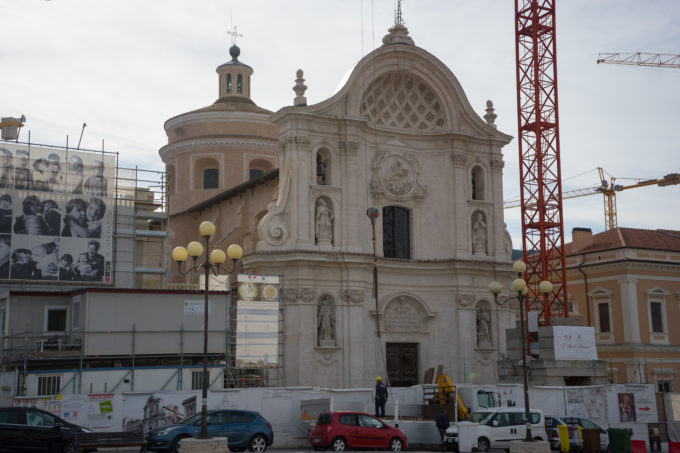
Chiesa di Santa Maria del Suffragio
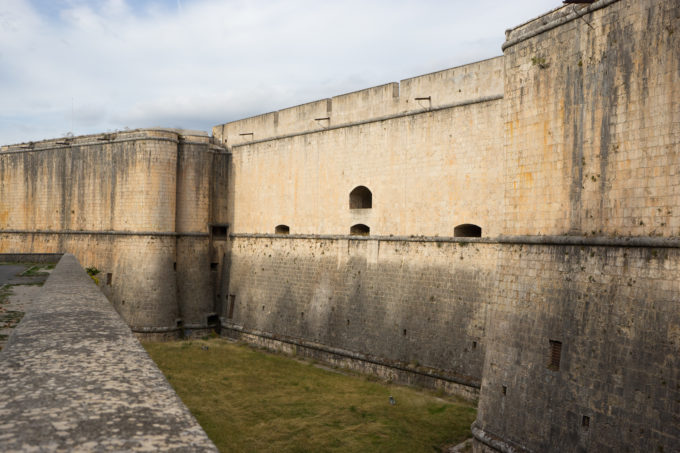
The formidable 16th century castle, home to the National Museum of Abruzzo
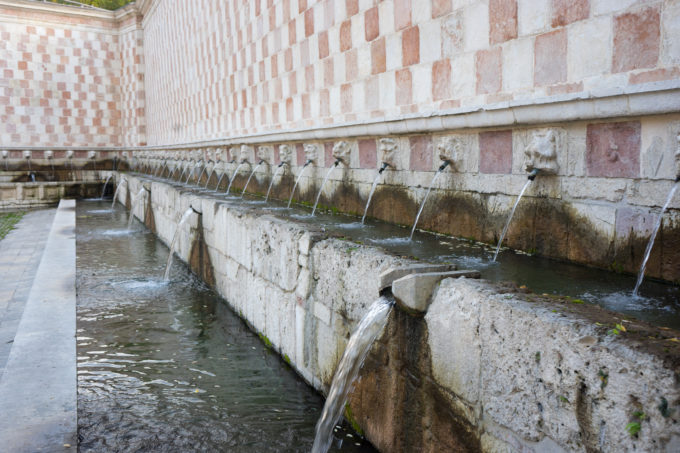
The 13th century Fountain of 99 Water Spouts
L’Aquila is also home to Fratelli Nurzia, producers of fine, soft torrone aquilano (honey nougat- try the chocolate and hazelnut and white torrone with almonds varieties) since 1835 so don’t forget to buy a box to take home. They have a bar in Piazza del Duomo (closed when we visited). We also visited newer torrone producer, just outside L’Aquila called Dolci Aveja to tour their factory and sample their decadent products. Only top, super-fresh ingredients are used at Dolci Aveja. We were given a tour by Mariano and Maria Teresa whose family own the bakery. It was evident how much thought and consideration was put into each creation as they tried to create the best product possible. Their torrone and ferratelle (waffle biscuits) were the best we tried the entire trip. The way their chocolate broke (one of the tests for fine chocolate) and melted was perfect. It is a real joy to visit a producer that cares so much about their product and manage to create such fine products.
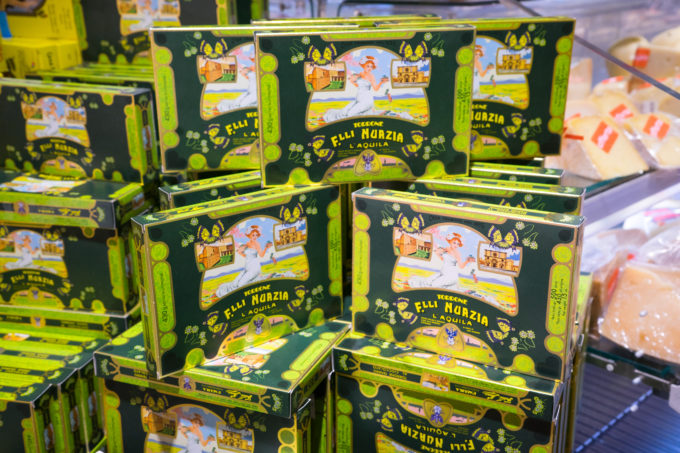
Fratelli Nurzia torrone
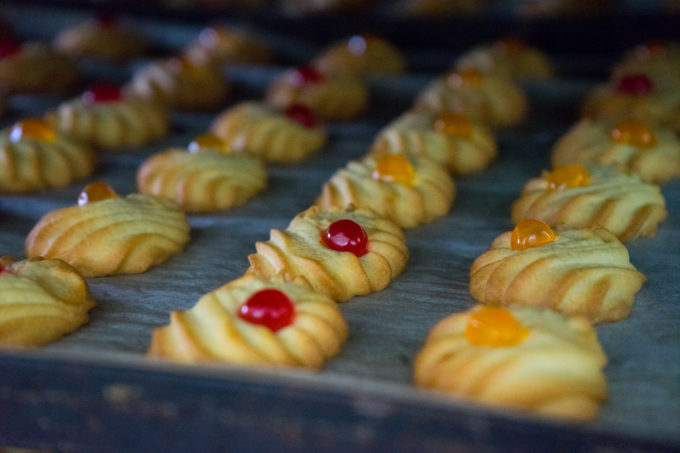
Biscuits at Dolci Aveja
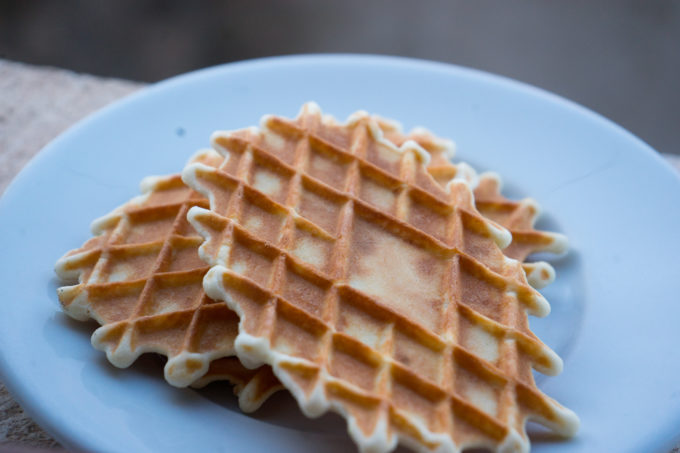
Dolci Aveja’s Ferratelle (anise-flavoured waffle biscuits typical of Abruzzo) which can be served with icing sugar, sandwiching grape jam or rolled and stuffed with sweet saffron-flavoured ricotta, custard or chocolate custard
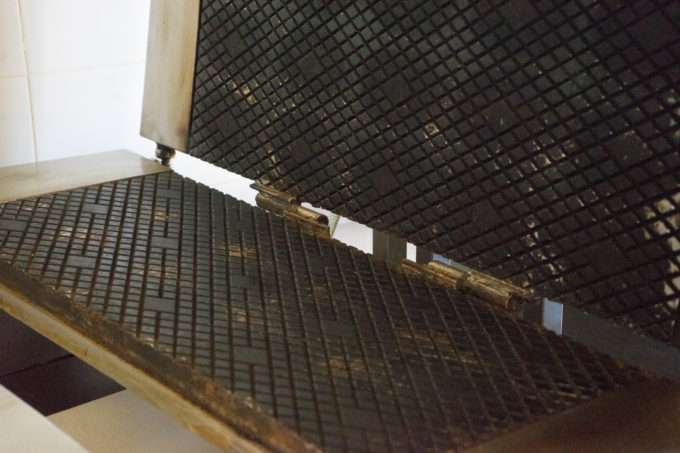
Iron for making ferratelle biscuits
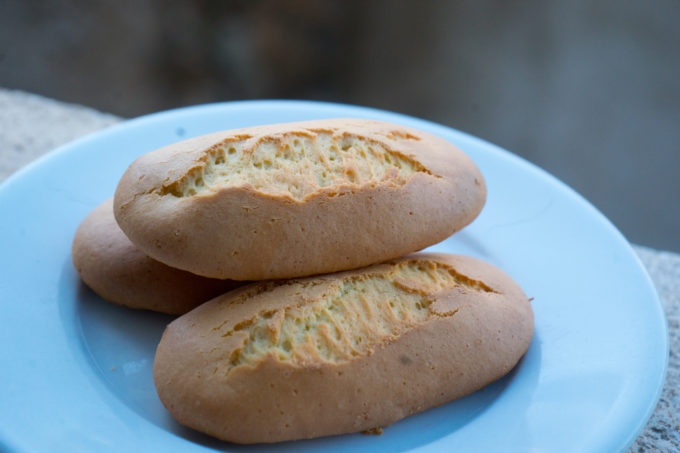
Dolci Aveja’s biscotti di latte – sponge biscuits
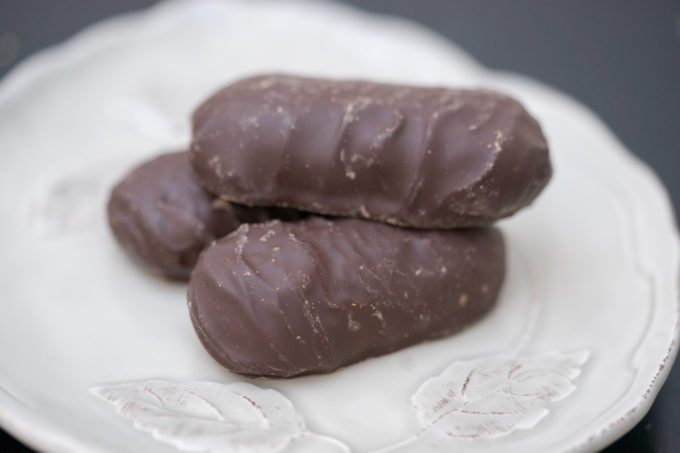
Dolce Aveja’s torroncini – an absolute must try
Paganica and Oricola
Reluctantly we looped back down to catch our flight from Rome, stopping in Paganica to visit their famous butcher, Ugo DePaulis. DePaulis has for three generations been producing top quality salumi from locally grown livestock from the Gran Sasso using traditional methods. They are most famous for their Cuore di Paganica, a giant, flavourful but delicate culatello (the best part of the prosciutto). We were not disappointed. Their guanciale, cured pig’s cheek flavoured with pepper and chilli and smoked, which was a staple for the shepherd’s in the Apennines is an essential in many dishes including amatriciana, was also delicious.
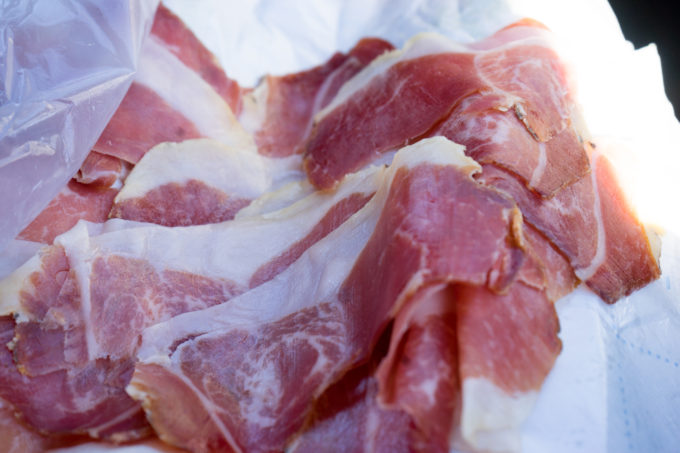
Cuore di Paganica– a large culatello
We stopped at an organic agriturismo, AgriQuartuccio, in Oricola on our way back for lunch and joined long tables of Italian families gathered for a Sunday lunch. There were play areas for the children outside and donkeys, sheep and pigs. The menu was seasonal so changes frequently but everything was delicious and a perfect end to a perfect trip. Next we need to explore Chieti and the coastal areas of Abruzzo.
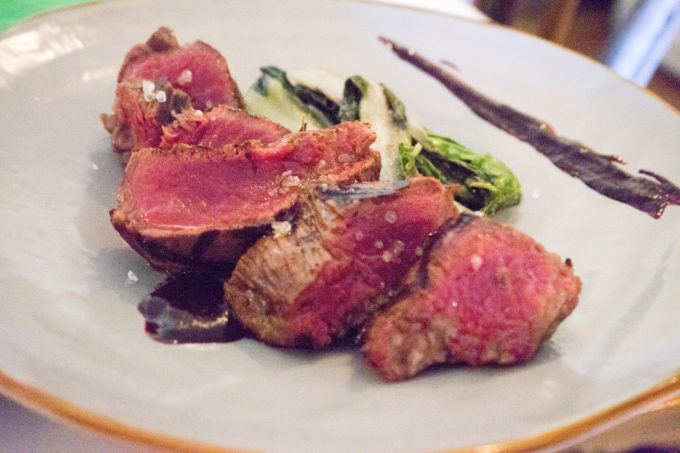
Steak
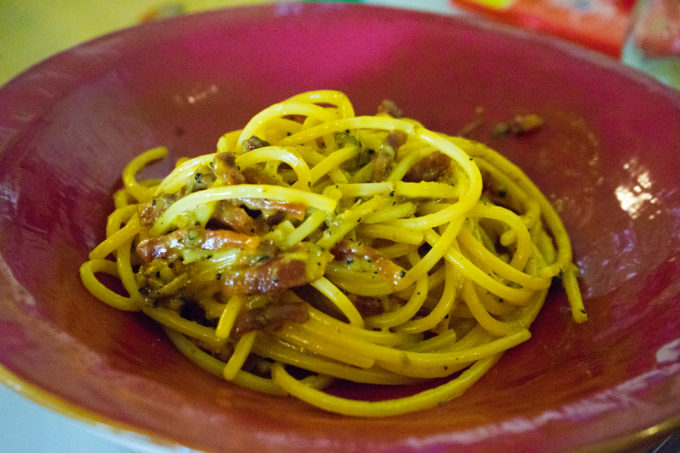
Spaghetti with guanciale and saffron
What to see:
Carsoli:
L’Angolo d’Abruzzo
Piazza Aldo Moro, 8, 67061 Carsoli AQ
Tel: +39 0863 997429
This restaurant has been run by the Centofanti family since 1986 with the philosophy of respect for the land, sustainable agriculture and sheep farming. It is a classic Abruzzese country style restaurant with a great wine list.
Recommended: shaved raw porcini mushroom salad, grilled scamorza cheese with prosciutto from Maiella Park, grilled meats, pappardelle with mutton ragù and pecorino from l’Alta Valle del Turano and fettuccine made with Solina ancient wheat and ragù Abruzzese made with 3 different meats and pecorino from l’Alta Valle del Turano.
Oricola:
AgriQuartuccio Agriturismo Biologico
Strada Provinciale del Cavaliere, 67063 Oricola AQ
Tel: +39 333 836 8619
https://www.agriquartuccio.it/en/
This agriturismo was the perfect Sunday lunch spot in the countryside with plenty of space for children to run, excellent food, animals to see and even a pool in hotter months. The menu is seasonal but everything we tried was delicious.
Anversa degli Abruzzi:
Porta dei Parchi
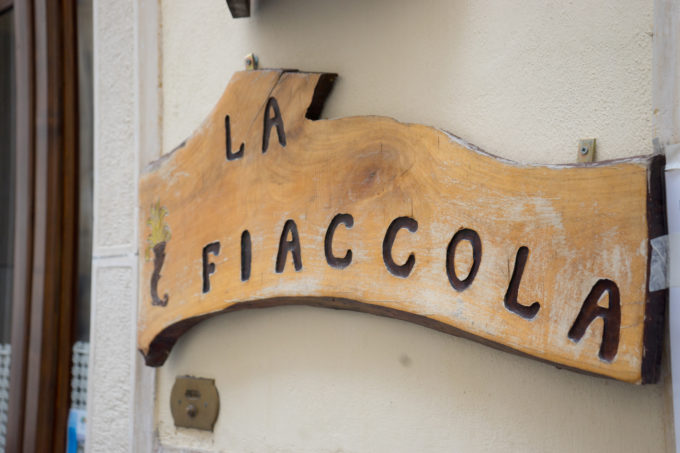
La Fiaccola
Sulmona:
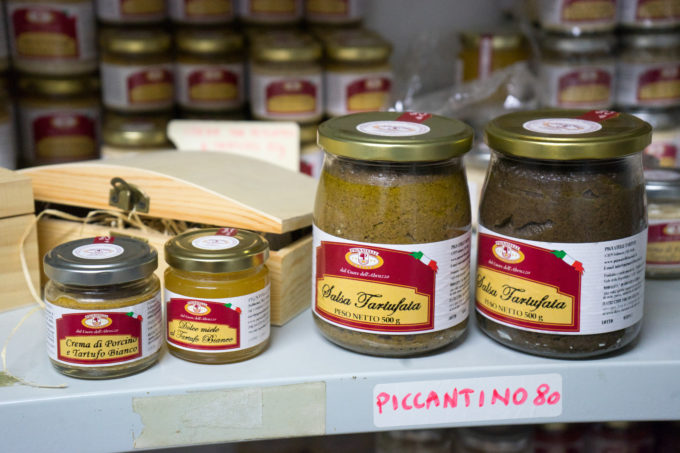
Truffle sauces
Pignatelli Tartufi

The Pelino factory and museum
Confetti Pelino
Pratola Peligna:
Pastaficio Masciarelli
Scanno:
Pan dell’Orso Pasticceria

Biscotteria Artigianale Di Rosati Liliana
Rivisondoli:
Ristorante Da Giocondo
Via del Suffragio, 2, 67036 Rivisondoli AQ
Tel: +39 0864 69123
http://www.ristorantedagiocondo.it
Campo Imperatore:

Mucciante- the place to stop and buy food to grill
Ristoro Mucciante
Navelli:

Crocus sativa buds
Agriturismo La Casa Verde, Cooperativa Alto Piano di Navelli
67020 Navelli (AQ)
Tel: +39 0862 95 91 63
Castel del Monte:

Finally the cheese is ready to be labelled Canestrato di Castel del Monte
Azienda Zootecnica “Gran Sasso” di Giulio Petronio
67023 Castel del Monte (AQ)
San Pio delle Camere:
La Cabina
L’Aquila:
La Fenice Enoteca Wine Bar
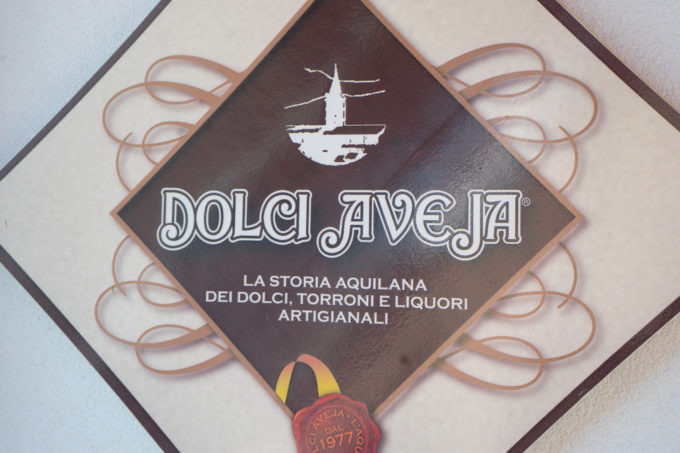
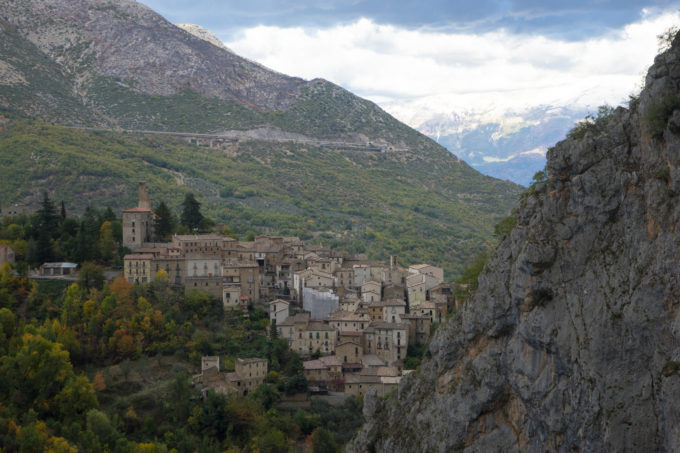
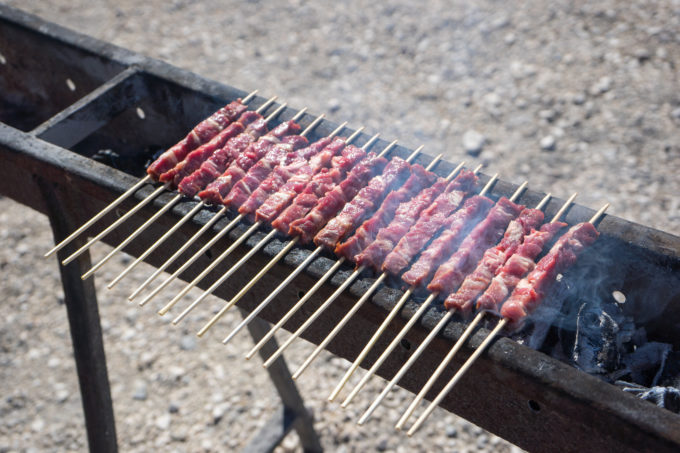
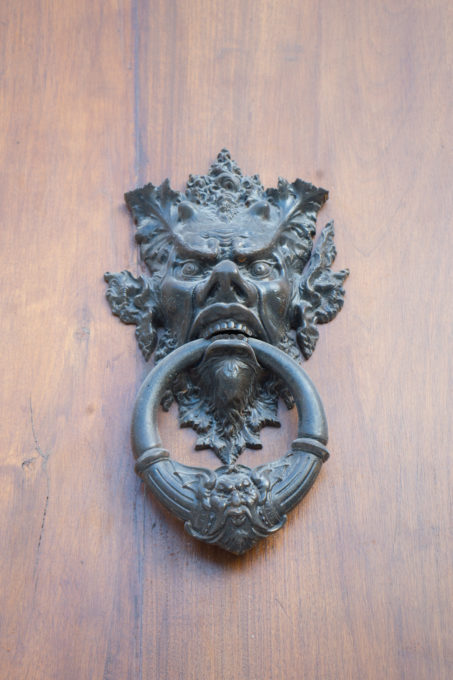
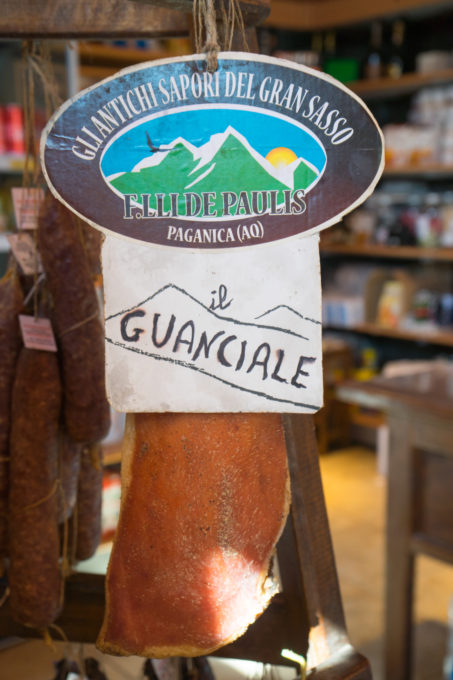
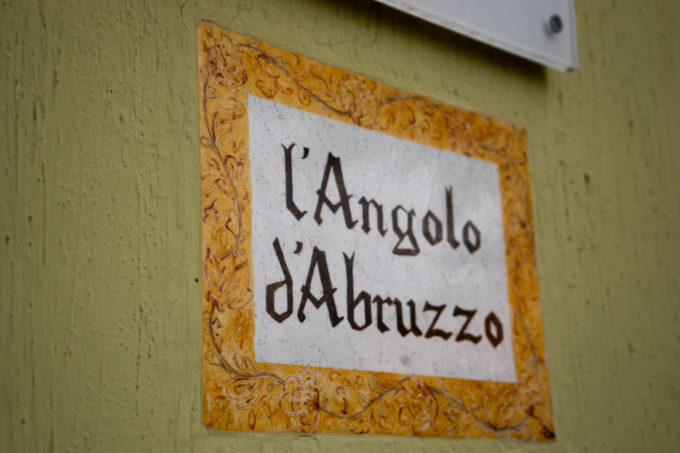
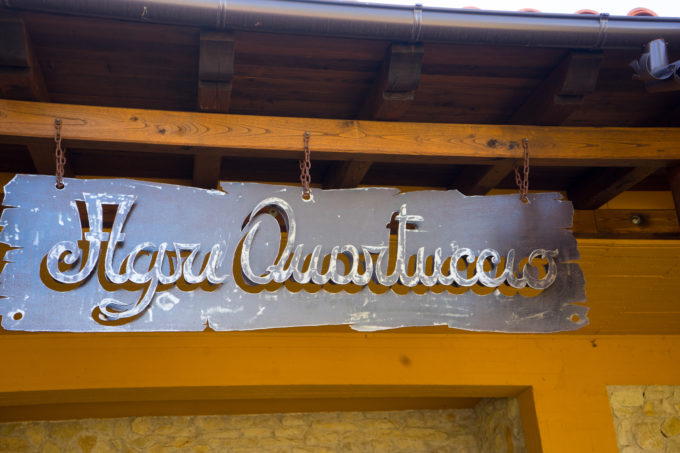
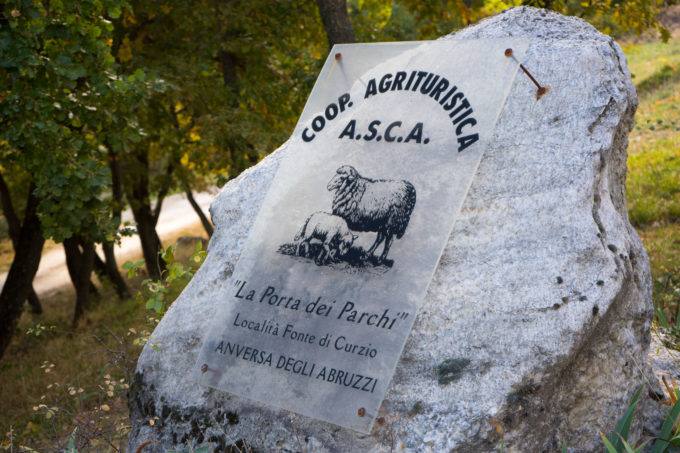
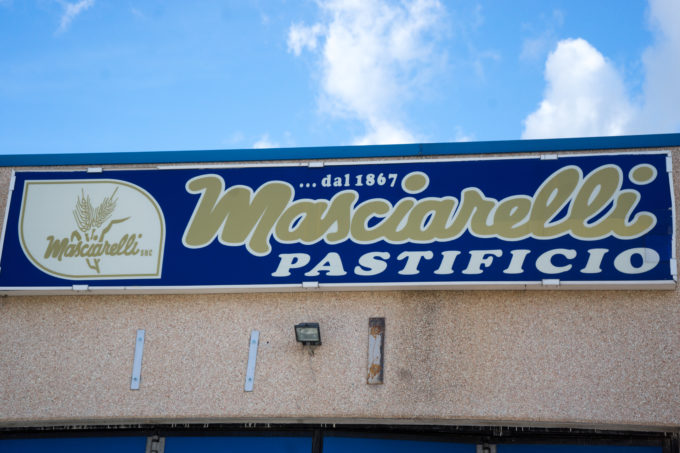
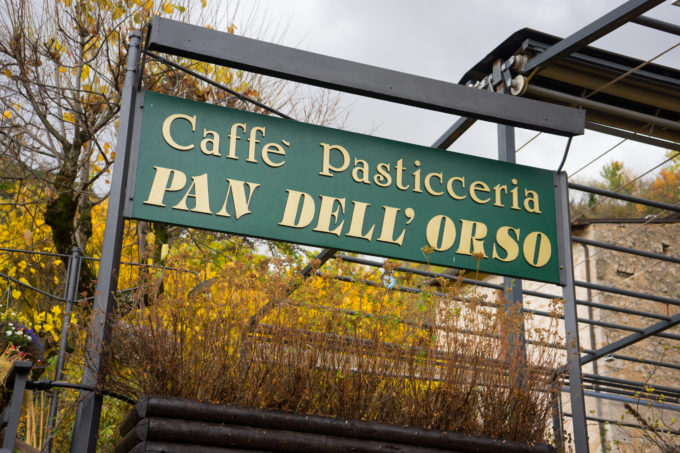
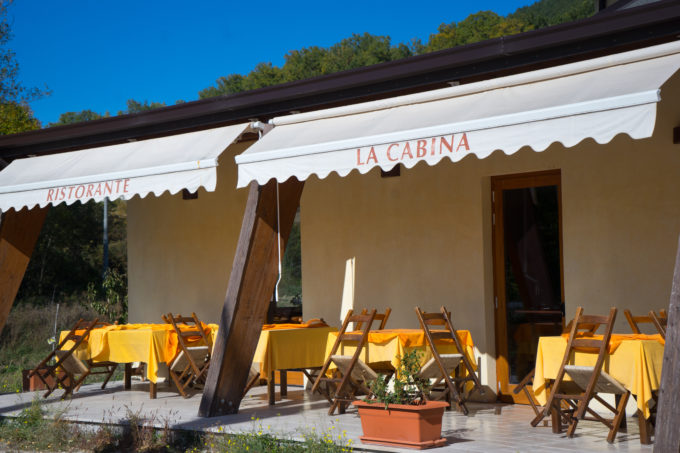
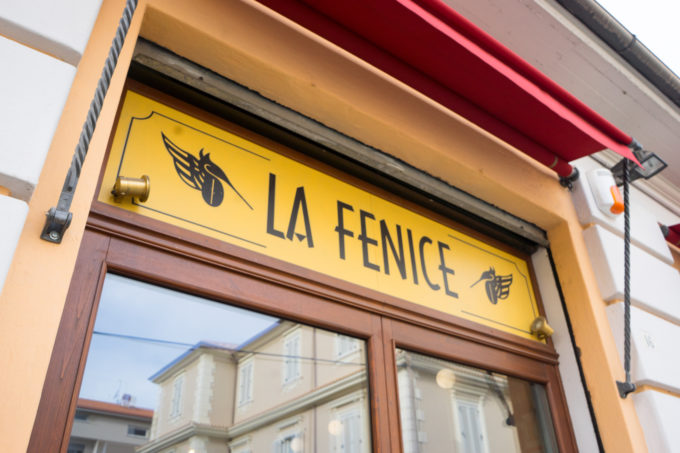
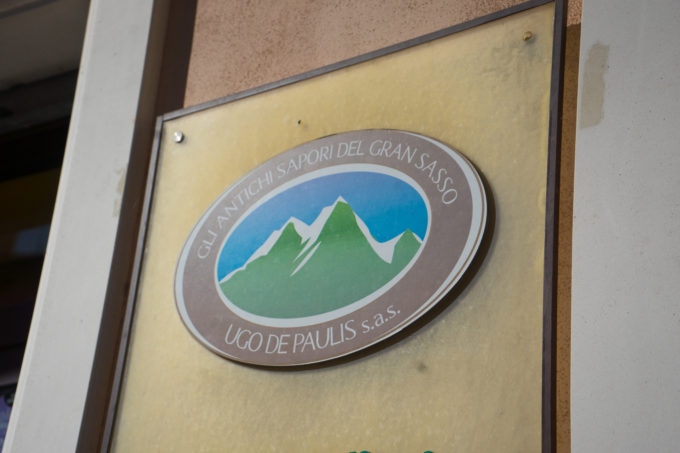
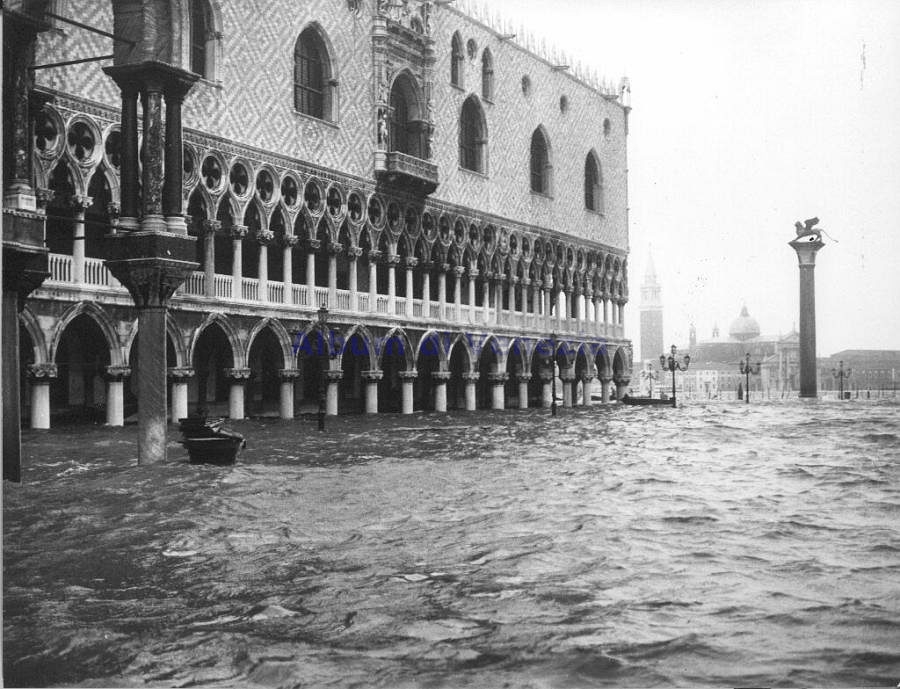
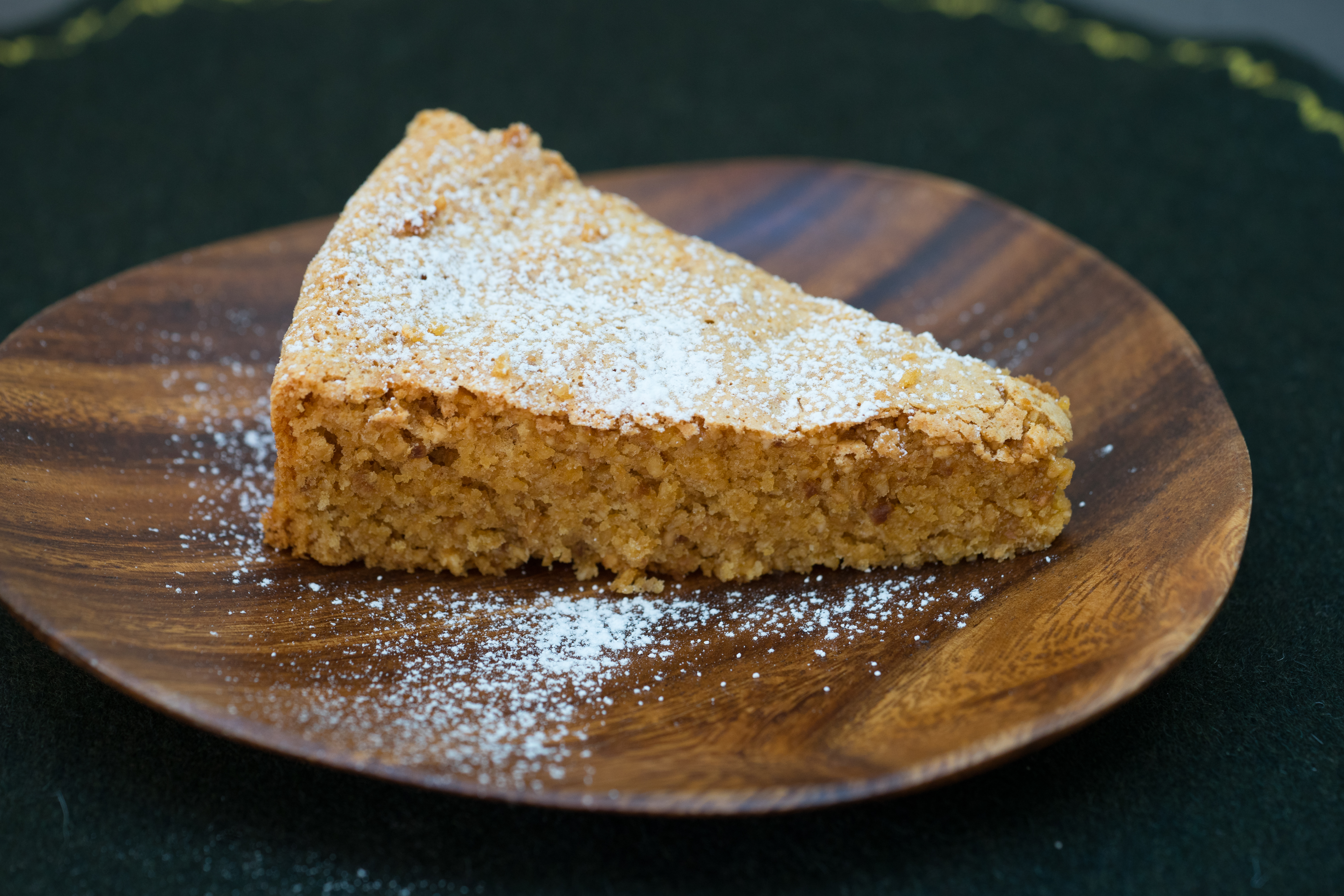
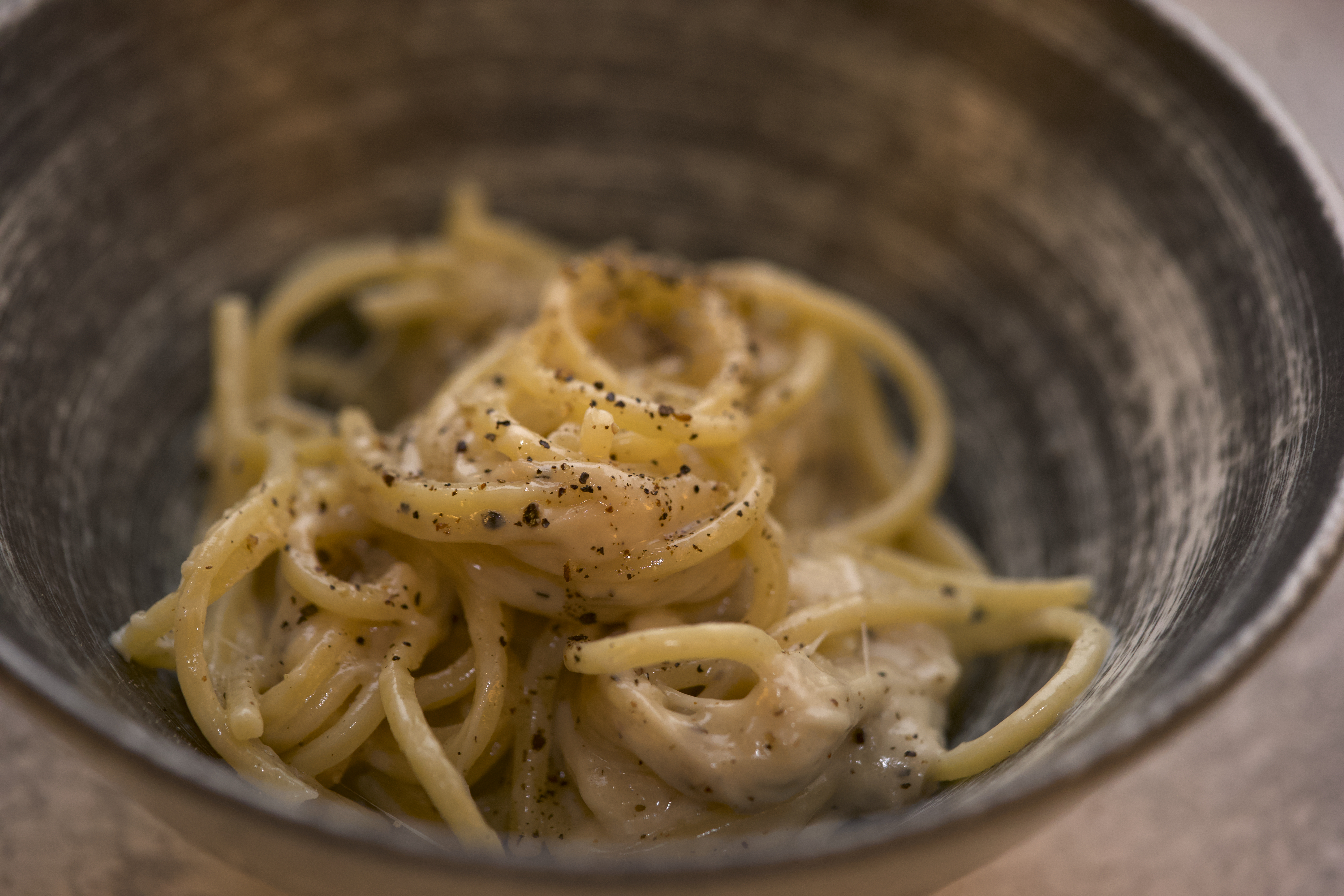
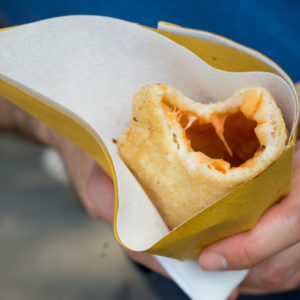
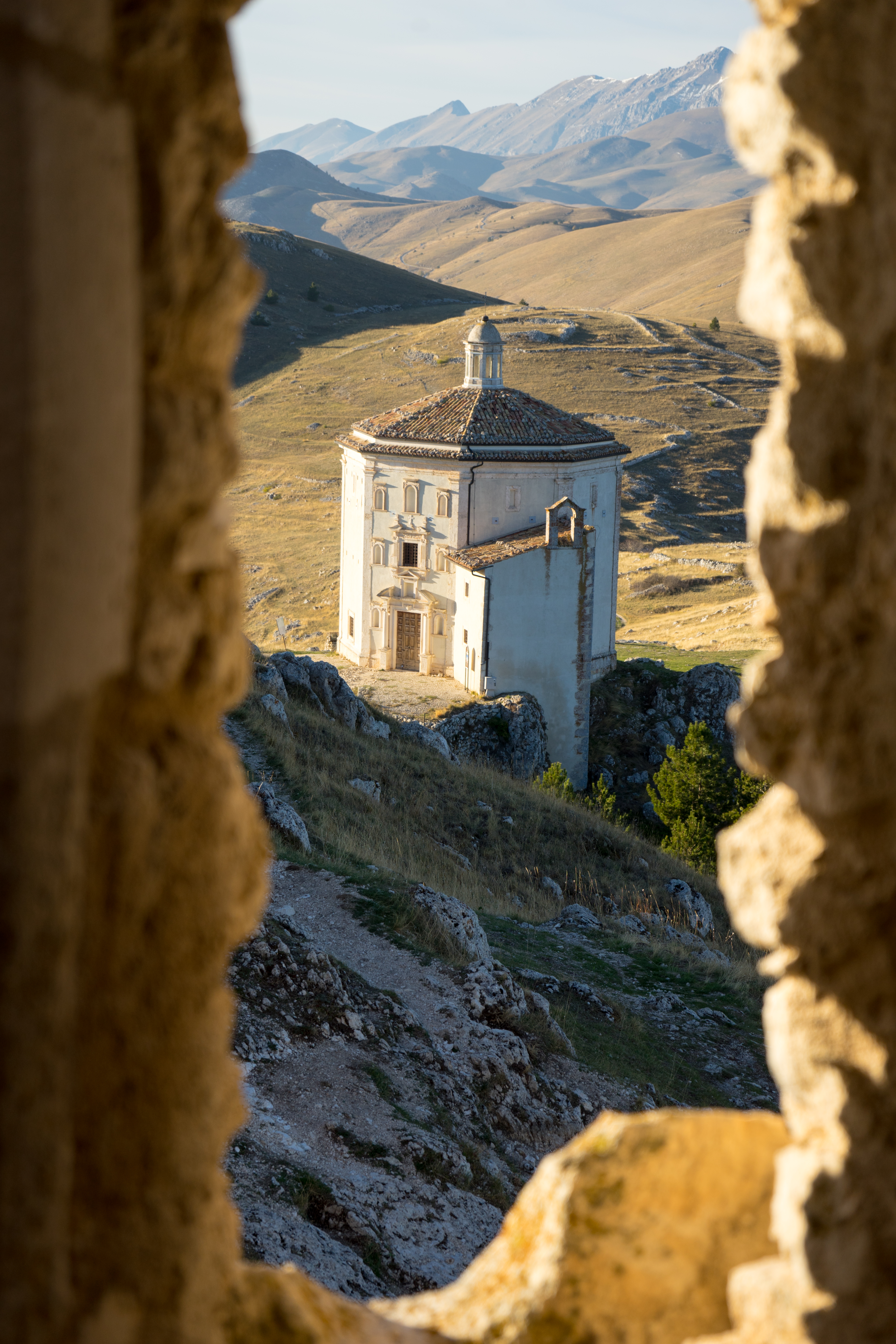
Sensational essay!
Thanks for sharing.
Thanks Sam. I am glad you enjoyed it.
amazing report! we tried dolci aveja from amazon and was amazing. we ll try again their aveja nugat and thanks to you for the suggest 🙂
next time we will try to visit abruzzo
Definitely worth a visit. You can see the quality of the ingredients that go in and the passion behind their products. I did not know you could buy it on Amazon though so thanks for the tip!